




2 CELEBRATING OUR PASTAND OUR FUTURE: THE COLLEGE OF NATURAL RESOURCES REACHES 30 YEARS

8 HIGHLIGHTS OF EXCELLENCE
An Integrated Approach to Forestry
Interdisciplinary, Ecology-Based Rangeland Science
Agricultural Economics: Cost, Value, and Sustainability Societyand Environment: Starting Rural, Going Global From Forests to Fields: Entomologyand Pest Management
The Journeyfrom Home Economics to Nutrition and Toxicology Plant and Microbial Biology: A Centuryof NewFrontiers From the Ground Up: Revealing the Science of Soil
22 FACULTYAND SPECIALISTS
NewFaculty: Max Auffhammer, Eileen Hebets, Max Moritz, and Kathleen Ryan Awards: Inez Fung, RosemaryGillespie, Garrison Sposito, Patricia Zambryski, and The Encyclopedia of Insects

25 COLLEGE SUPPORT
Hilgard SocietyDonors

Profile: Diane Yu
Tribute to Daniel Arnon: 50th Anniversaryof KeyPhotosynthesis Discoveries


Gump Station Celebrates 20 Years in Moorea
Visit our website! S ee the inside back cover for new online features.
College
Class of 1974: The First Graduates of the College of Natural Resources Historical Reflections
© 2004. The Regents of the University of California. All rights reserved. Breakthroughs is a registered trademark and is published for alumni and friends of the College of Natural Resources.
all
Please direct
Telephone: (510) 643-8860
E-mail: breakthroughs@nature. berkeley.edu
Shortlyafter 9:00 a.m. on July1, 1974, the first meeting of the facultyof the College of Natural Resources was called to order in Birge Hall byChairman RudyF. Grah. Among the announcements were the selection of Loy L. Sammet as Acting Dean of the newcollege and the reading of a directive byChancellor Bowker establishing the College of Natural Resources, and designating Giannini Hall as its administrative home. Chancellor Bowkerís directive was the culmination of at least three years of work bythe College of Natural Resources Organizing Committee, chaired byprofessors J. N. Boles and Grah. The merger of the College of Agricultural Sciences with the School of Forestryand Conservation to create CNR had its roots in the Berkeleycampusís Revised Academic Plan of 1969-1975, which called for their ìintegration into a comprehensive educational program dedicated to the exploration of land resource questions.î

John Zivnuska and E. G. Linsley, the last deans of Forestryand Agricultural Sciences respectively, forged a remarkable collaboration to bring forth a college that would respond to the environmental and resource issues of the state. Suggested names for the newcollege included ìThe College of Renewable Resource Managementîand ìThe College of BioResources.îIn hindsight, neither of these seems as appropriate as the one selected. The College of Natural Resources has grown into its name and its roleóon the Berkeleycampus, within the UC system, and nationally.
Manyof the production aspects of agriculture had been transferred to the Davis campus, but Berkeleycontinued at that time and continues todayto playa vital role in resource issues related to agricultural lands and the entire resource base of the state. Without the foresight of Zivnuska, Linsley, Boles, Grah, and manyother College and Universityleaders, it is unlikelythat a department such as Environmental Science, Policy, and Management could have been imagined or formed in the reorganization of CNR that took place a dozen years ago. Similarly, our departments of Plant and Microbial Biology, Agricultural and Resource Economics, and Nutritional Sciences and Toxicologyare recognized leaders in their fields and at Berkeley.
Today, our college remains an experiment. New majors in Molecular Toxicology, Microbial Biology, Environmental Sciences, and Molecular Environmental Biologyhave been added to provide students with training for an ever-changing world. Our Environmental Economics and Policymajor has been opened up to students from the College of Letters and Sciences. CNR has just hired the first professor of bioethics at the Berkeley campus. These changes will ensure that the College continues to attract the finest students.
While College leaders at the time of the formation of CNR could not have anticipated the advances in genetics, remote sensing, economic theory, and nutrition that have occurred, theydid recognize that change is a constant, and theydesigned a college to
embrace whatever changes occurred. They could not have anticipated the controversies over GMOs, the role of corporate funding in research, or forest and fire management practices, but theyrecognized that Berkeleyis a place where all sides are heard, issues are debated, and ideas are molded. Theycould not have imagined the cycles of budget difficulties that have left the College with far fewer financial resources, but theyinfused a culture of excellence and scholarship that survives those challenges.
The experiment continues, and CNR, with its roots as the first college of the UC Berkeley campus, continues to reshape itself to serve the students and the citizens of California. Zivnuska imagined a college that would ìembrace the environment in which man lives and the biological, technical, and social processes that man uses to produce the food, fiber, and other materials that he requires.î
Were he looking today, he would note that more than half of our students are not ìhe,î but ìshe,îand that the College serves all of humankind. And he would be proud.








The College dates back to the original charter of the Universityof California in 1868.
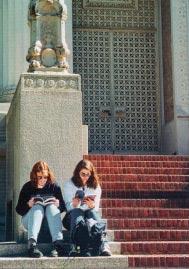


The California Constitution of 1849 mentioned creation of a state university. But no action was taken until the passage of the 1862 Morrill Land Grant College Act, which offered federal land grants to states that established agricultural colleges. The state legislature officiallycreated the Agricultural, Mining, and Mechanical Arts College in 1866 and began looking for a location to site the college.
Meanwhile, former Congregational minister HenryDurant founded the College of California in Oakland, with a curriculum modeled after Yale and Harvard. By1867, the college was financiallytroubled, and trustees of both educational institutions agreed to combine their resources to form a ìcompleteîuniversity. In 1867, the College of California donated its land and dissolved the institution to merge with the newlyformed agricultural college. In March 1868, the governor signed the Organic Act, establishing the Universityof California. The College of Agriculture was the first college established on campus. The newuniversitywas sited on 160 acres four miles north of the original College of California, in a place called Berkeley.
The College of Agriculture started slowlyunder its first dean, Ezra Carr. In 1875, however, Eugene Hilgard assumed leadership of the College and set forth a vision that remains today: bring the highest caliber of science to bear on practical problems and use this knowledge to train the leaders of the future. Born
in Bavaria and trained in Germany, Hilgard was a respected scientist and passionate educator. He realized that agriculture suffered a poor reputation among scholars as a scientific endeavor, while farmers simultaneouslyhad little interest in academia.
His meticulous research categorizing the nature of alkaline soils in California and revealing their importance to agricultural production, along with his detailed studies of the impacts of the fungal pathogen phylloxera on grapevines, convinced both the scholarlyand agricultural communities of the value of the College of Agriculture (see Entomologyand Pest Management, and Soil Science).
Hilgard brought the true inquisitiveness of science to his mission as dean. He recognized California as a unique and diverse environment, and set about performing fieldwork to determine the specific needs for agriculture in the state, rather than assuming that information and practices valid in Europe, or in the eastern U.S., would work here.
Through his fieldwork, Hilgard established the first agricultural experiment station in the U.S. and set the framework for the Division of Agricultural Sciences, nowthe Universityof California systemwide Division of Agriculture and Natural Resources. He took advantage of the funds provided bythe 1887 Hatch Act to establish research stations in the Sierras, the Coast Range, the San Joaquin Valley, and Southern California to allow research across a wide varietyof environmental conditions. By 1900, Hilgardís experiment station concept had become a resounding success and he had established a solid partnership with California agriculture.
S ince its creation, the College has brought the intellectual power of academia to the practical problems of society. This year, we celebrate our 30th anniversaryas the College of Natural Resources.
While two-thirds of our living alumni graduated from the College under this appellation, CNR is onlyone milestone in a long tradition.Students on the steps of Hilgard Hall.
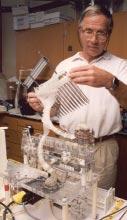
Hilgard also began in-the-field meetings called Farmerís Institutes to bring newfindings and new ideas directlyto the farmers. This idea continues todayas the Universityof California Cooperative Extension.
Although farmers accepted the benefits of bringing science to agriculture, theywanted a universityto offer practical training under actual farming conditionsó not possible on a large scale at the urban Berkeleycampus. In 1909, the UniversityFarm was established in Davisville (later renamed Davis) as a field station for Berkeleyagricultural research.
Forestryheld a place in research and education dating back to Hilgardís arrival on campus. In 1914, a formal Division of Forestrywas established within the College of Agriculture. The forestryprogram has evolved during the last 90 years, and still represents one of the most important areas of research and education within CNR (see Forestryand Rangeland Science).
In 1913, the Division of Rural Institutions was established, becoming the Division of Agricultural Economics by1926. A generous donation of $1.5 million dollars byAmadeo Peter Giannini, founder of the Bank of America, funded the creation of the Giannini Foundation and the building of Giannini Hall (see Agricultural Economics).

By1946, several Universityof California campuses had been established and a systemwide reorganization of agricultural programs ensued. The Division of Agricultural Sciences was created to oversee related programs at Berkeley, Davis, Los Angeles, and Riverside. As part of this restructuring, the forestry
program was separated from the College of Agriculture to become a professional school. In 1959, the Regents declared that Davis was to be a general campus of the University. Several programs originallylocated at Berkeleytook up permanent residence at Davis.
Today, the Division of Agricultural and Natural Resources still provides overarching programmatic support for the three remaining land-grant programs at Berkeley, Davis, and Riverside, including the Agricultural Experiment Station researchers, campus-based Cooperative Extension specialists, and county-based Cooperative Extension advisors. Chancellors and deans on each campus retain authorityover facultyhiring and evaluation, and over academic programs.

In the late 1960s and early1970s, societal views of agriculture, forestry, and the environment began to change. Agricultural production and environmental quality were examined with a newunderstanding of the impact of human actions on the natural world. Agricultureís political position in the University changed as well: the Chair of the State Board of Agriculture lost his position as an ex-officio member of the Board of Regents.
Earlier that era, in 1961, the College of Agricultural Sciences developed a newacademic plan emphasizing the basic sciences and strengthening graduate programs in entomology, genetics, molecular biology, and nutrition. Meanwhile, the School of Forestry expanded to include broader environmental and social research and in 1968 was renamed the School of Forestryand Conservation.
The College of Agricultural Sciences and School of Forestryand Conservation were separate, but theyshared programmatic strengths and a great degree of facultyand student interaction. The College offered lower-division courses in soils, genetics, entomology, pathology, and resource economics, which supported upper division programs in both academic units. Both units contained internationallyrecognized graduate programs. Theyeven shared a verypopular joint major, Conservation of Natural Resources, a program that was initiallyproposed byRichard Doutt, acting dean of the College of Agriculture, and developed bya group of facultyfrom both units.
Yet several factors were pointing towards a need to consider organizational change. While interest in forest and resource management and enrollment at the School of Forestryand Conservation were high, the Collegeís undergraduate enrollments were declining. Students planning to pursue a career in production agriculture typically attended Davis rather than Berkeley, and there was strong internal and legislative pressure to reduce duplication of programs across campuses.
Beginning in 1968, several committees and a task force were formed to discuss

1862 Morrill Land Grant College Act passed,authorizing land grants to states that established colleges of agriculture and mining arts.
1868 Organic Act established the University of California.

1875 Eugene Hilgard assumed leadership of the newly formed College of Agriculture.
1912 Agricultural Hall completed (renamed Wellman in 1968).
1914 Division of Forestry established in the College of Agriculture; at that time,College had 17 teaching units,including the Agricultural Experiment Station and Extension Service.
1917 Hilgard Hall dedicated.
1925 Purnell Act allocated funds for study of Agricultural Economics and Rural Sociology at land-grant universities.
1928 Amadeo Peter Giannini donated $1.5 million to establish Giannini Foundation and build Giannini Hall.
1930 Giannini Hall completed,Giannini library established.
1939 Division of Forestry became Department of Forestry; College of Agriculture reorganized into four departments: forestry,agriculture,home economics,veterinary medicine.
1946 School of Forestry established as separate professional school.
1946 University systemwide reorganization of agricultural programs: Division of Agricultural sciences established encompassing related programs at Berkeley, Davis,Los Angeles,and Riverside.
1961 Universitywide Academic Plan called for diversification of agricultural colleges on three campuses; Berkeley became College of Agricultural Sciences.
1974 College of Natural Resources created from merger of College of Agricultural Sciences and School of Forestry and Conservation.
1992 College of Natural Resources reorganized into four departments: Agriculture and Resource Economics; Environmental Science,Policy,and Management; Nutritional Sciences and Toxicology; and Plant Biology.
1996 Division of Microbial Biology established as part of Department of Plant and Microbial Biology.
1998 Environmental Sciences established as first joint undergraduate major with College of Letters and Science.
merging the College of Agricultural Sciences and the School of Forestryand Conservation. Effective July1, 1974, undergraduate programs of both were combined into a single College of Natural Resources.
The mission of the newcollege was stated bythen BerkeleyChancellor Albert H.
Bowker: ìThe central concern of the college will be with the renewable resources of all non-urban lands of the stateóforests, grasslands, farms, brushfields, and barren lands. Its efforts will provide the scientific knowledge, professional skills, and awareness of public purposes needed for the use and management of these resources.î

College of Agricultural Sciences Dean LoySammet said at the time ìAfter more than 100 years of successful academic involvement in the growth of California agriculture, we viewthe reorientation signaled by this merger as a healthyadaptation of the Collegeís capabilities to changing social needs in resource use.î
Implementation of the newplan took several years. Conservation and Resource Studies, which had been operated as a program out of the Office of the Dean, was expanded into a department. The forestry program initiallyconsisted of two departments: Forestryand Conservation, which operated the research side of the program, and Forestryand Resource Management, which contained the teaching program. In 1978, Department Chair Dennis Teeguarden consolidated the departments into Forestryand Resource Management.
Separate departments remained for Agricultural Economics, Cell Physiology, Entomological Sciences, Plant Pathology, Nutrition and Dietetics (see Nutrition and Toxicology), Genetics, and Soils and Plant Nutrition.

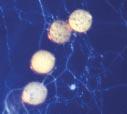

A campuswide reorganization of biologyled to additional changes in the College (see Plant and Microbial Biology) and bythe 1990s, the time had come once again to evaluate the Collegeís structure and programs. The reorganization aimed to coordinate and strengthen the Collegeís interdisciplinaryapproaches to critical environmental problems and add newmajors focusing on environmental biologyand resource management.
In 1992, the Department of Environmental Science, Policy, and Management (ESPM) was created, consolidating several of the departmentsó Conservation and Resource Studies, Soils, Forest and Resource Management, Entomology, and Plant Pathologyóinto one unit that remains today. ESPM nowhas three divisions: Ecosystem Sciences, Society
and Environment (see page 13), and Insect Biology. CNRís other current departments include Agricultural and Resource Economics, Plant and Microbial Biology, and Nutritional Sciences and Toxicology.
The latest reorganization also established research centers and facilities where the Collegeís Cooperative Extension specialists and faculty researchers can work together to fulfill the landgrant mission of the College, and bring science-based insight to real-world issues such as wildland fire, childhood obesity, agricultural sustainability, water rights, and biotechnology.
The effect of the reorganizations has been real but subtle. Newfacultywere recruited and newcurricula developed to address the changes in studentsí interests over time. Research areas were broadened to reflect scientific advances in the facultyís fields of expertise. But the Collegeís mission to research, educate, and extend knowledge to improve the lives of Californians has remained constant.
While CNR facultyand Cooperative Extension specialists maintain the disciplinaryexcellence that is the hallmark of UC Berkeley, scientific and environmental issues more and more often cross disciplinary lines. Today, facultymembers participate in broadbased initiatives that recognize the complexityof the issues facing society.
For example, experts in atmospheric science, forest biology, rangeland ecology, and agricultural economics are working together to address the multifaceted issues surrounding global climate change. Entomologists and plant biologists are working with colleagues in public health to identifyand stayahead of devastating emerging diseases. Societal issues are addressed broadly, including biotechnology, environmental ethics, intellectual propertyrights, and land
development along the urban-wildland interface.
Student enrollment at the College has waxed and waned over the years. One of the greatest challenges for Ezra Carr, the first head of the College, was attracting students. Interest in forestryand resource management peaked in the 1930s and 1970s, reflecting national trends. Yet enrollment in the School of Forestryhit a lowin the mid-1940s, dropping from 93 graduates in 1939 to four graduates in 1945, due to both student and facultymilitaryservice. Today, as the College designs programs to meet the interdisciplinaryinterests of its present and future studentsósuch as the joint program with the College of Letters and Science in Environmental Sciencesóenrollment is on the upswing again.
Our buildings also represent both a rich historyand a challenge. The buildings that house CNR reflect the great researchers and supporters who developed the College. The Agriculture Groupó Wellman (1912), Hilgard (1917), and Giannini halls (1930)ó was designed bythe famed architect John Galen Howard, who designed much of the original campus. The group is listed on the National Register of Historic Places and is a designated landmark of the campus, the Cityof Berkeley, and the State of California. Mulford Hall (1948), Morgan Hall (1953),
which holds the famous ìpenthouseîused for the first live-in nutrition studies, and Koshland Hall (1990) house the other College programs.
While the grandeur of these buildings reflects an illustrious history, all but Koshland are insufficient for the research needs of todayís scientists. From seismic concerns to outdated laboratories, one of the Collegeís greatest challenges is to bring its facilities up to the par of its facultyand students.
Throughout its history, the College has been home not onlyto outstanding scientists, but to remarkable people in all aspects of their lives. The facultyís keen interest in students has built a reputation that the College still enjoys as having close studentfacultyinteraction.



ìThat high caliber continues todayin our faculty, specialists, staff, and students, and allows CNR to fulfill its mission of training the leaders of the future,îsaid current Dean Paul Ludden.
While names and even programs may change, this themeóexcellence in research, instruction, and outreach among a communityof dedicated individualsócarries the College forth into a future of exploration on the frontiers of science.

For more information on the historyof the College of Agriculture, the School of Forestry, and the College of Natural Resources, you maywant to consult the following resources, which provided manyof the historical details for this article.
Casamajor, Paul, ed. ForestryEducation at the Universityof California: The First 50 Years. Berkeley: California Alumni Foresters, 1965.
Helfand, Harvey. Universityof California, Berkeley, Campus Guide: An Architectural Tour and Photographs. Princeton Architectural Press, 2002.
Scheuring, Ann Foleywith Chester O. McCorkle and James Lyons. Science & Service, A Historyof the Land-Grant Universityand Agriculture in California. The Regents of the Universityof California, Division of Agriculture and Natural Resources, 1995.
Teeguarden, Dennis E. and John A. Zivnuska. Shaping Forestryís Future: 75 Years of ForestryEducation at the Universityof California, 1914-1989. The California Alumni Foresters in cooperation with the Department of Forest and Resource Management. UC Berkeley, 1991.
Universityof California HistoryDigital Archives, http://sunsite.berkeley.edu/uchistory/ and http://dynaweb.oac.cdlib.org:8088/dynaweb/uchist/public /inmemoriam.
have made major contributions to science and society. The accomplishments of the College are too numerous for us to comprehensively address in this special issue. The following sections highlight just a few areas in which the College has both a strong history and exciting future:forestry,rangeland science,agricultural economics,social science, entomology and pest management,nutrition and toxicology,plant and microbial biology,and soil science. Throughout the College's history,common values persist:adaptation to social change,development and adoption of new technology, and advancement of an interdisciplinary world view.

Although a forestryprogram was first proposed at Berkeleyin 1886 and again in 1899, it did not get off the ground easily. The Universityof Southern California opened a forestryschool in 1889 but it closed within one year. Proposals failed to pass the state assemblyin both 1903 and 1905. But researchers with the College of Agriculture were still active in forestry.
It took enthusiastic student interest and advocacy, as well as facultysupport, to establish a formal home for the studyof both the basic aspects of forest biologyand the practical aspects of timber harvesting. The student forestryclub began in 1911 and in 1914, the College of Agriculture launched a Division of Forestry.
The first head of the forestryprogram, Walter Mulford, set forth a lasting vision for forestry, just as Hilgard had done for the College. He developed a strong undergraduate program based for the first two years on general academic enrichment, followed byspecialization in either forest management or logging engineering in the upper division courses. He established forestrysummer camp, an intensive field course that continues to this dayas one of the strongest communitybuilding educational experiences on the Berkeleycampus. And he founded an outstanding forestrylibrarybydonating his own collection of books.
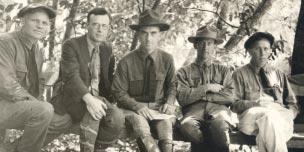
In 1922, the forestryprogram also launched a program in grassland ecologyand management, housed todayin the Division of Ecosystem Sciences (see Rangeland Science).
In 1926, WoodyMetcalf was appointed as the first Cooperative Extension forester. He played a keyrole in developing better rural fire protection throughout the state. In 1934, Frederick Baker, a professor of silviculture at Berkeley, produced Theoryand Practice of Silviculture, the first American textbook in its field.
Other major forestryresearch took place during these years. Joseph Kittredge Jr., who came to Berkeleyin 1932 as professor of forestryand an ecologist in the Agricultural Experiment Station, pioneered studies on the effect of forest vegetation on water storage and snowmelt. Harold Biswell, who joined the facultyin 1947, conducted the first experiments using prescribed burning to reduce the risk and severityof wildfire in California.
ìBiswell was the first to challenge the orthodoxybyasking if we were doing the right thing by eliminating all fire. That was a reallyradical idea at the time,îsaid Professor Emeritus Dennis Teeguarden, former chair of the Department of Forestryand Resource Management.
The field of forest photogrammetryalso owes much to Berkeleyresearch. Bob Colwell, a Berkeleyplant physiologygraduate, joined the facultyin 1947. He was one of the first experts in the young field and was a catalyst for the development of remote-sensing techniques. He went on to playan instrumental role in the launch of LANDSAT 1, which revolutionized the fields of cartography, forestry, geology, and land use.
Just before Mulfordís 1946 retirement, the division was separated from the College of Agriculture into a professional school as part of the establishment of the UC systemwide Division of Agricultural Sciences. As a professional school, the School of Forestrycould offer onlyupper division and graduate programs. The lower division pre-forestryprogram remained with the College of Agriculture.
HenryJ. Vaux became dean of the School of Forestryin 1955. By1964, the School was rated among the top three or four programs in the U.S. A balanced approach between teaching and research and more visibilityfor the Agricultural Experiment Station marked his tenure. But Vauxís
greatest influence came later. He served as chairman of the State Board of Forestryfrom 1976 to 1983 and guided major revisions of the forest practice rules, which were based, in part, on research at Berkeley.
Professor John A. Zivnuska followed Vaux as the fourth dean of the School of Forestry(19651974). Zivnuska and Vaux were pioneers in establishing the field of forest economics as a subdiscipline of land and resource economics. Zivnuska was internationallyknown for his works in forest resource evaluation, industrial economics, forest taxation, long-term demand and supplyanalysis, and international forestry.
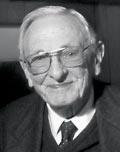

In 1967, the necessityof incorporating other academic disciplines into the studyof forestryled to the transfer of the campus wildlife and fisheries program to the School of Forestry, led by Professor Starker Leopold. Through his public service on several advisoryboards for the Department of Interior, Leopold set the framework for resource management policyin the National Park Service, and the national wildlife refuge system.
In addition to his scientific and policyaccomplishments, Leopold was known as one who could bridge gaps between diverse groups with opposing viewpoints over natural resource use. Leopold and his students made wildlife a strong and ongoing part of the research and curriculum. In 1968, the Schoolís name was changed to reflect this expansion, to the School of Forestryand Conservation.

ì When I came to Berkeley, forestrywas almost exclusivelyoccupied with the timber resources, as it was in most forestryschools around the country,îsaid Teeguarden. ìLegislation such as the Endangered Species Act and National Forest Management Act sent a clear message from society that forests are valuable on a broader basis than trees alone.îIntegrated management for a whole bundle of values became the goal.
Bythe 1970s, the Berkeleyprogram ranked as the nationís number-one forestryschool. Nearly all of the top positions in public forestrywere held byalumni, as were leadership positions in industryand academia.
Berkeleyís forestryprogram also made great strides in attracting females to a male-dominated field. It is believed that the first B.S. in forestryawarded to a woman was to Alice Craig from Berkeley(í28). But still, by1965, onlynine women had graduated from the Berkeleyprogram and onlythree had attended summer camp. However, growing interest in the environment in the 1970s led to more women considering forestryas a potential career. Last year, 60 percent of the forestry program graduates were female.

In 1984, Louise Fortmann, a rural sociologist, was recruited as the first female facultyin forestry at Berkeley. ìA lot of the ëfirst womeníappointed to academic units are unwelcome and their lives are made miserable. Here theytried to do everything theycould to help me,îsaid Fortmann. Professor Fortmann nowchairs the Division of Societyand Environment (see page 13).
Crucial to the forestryprogramís research and teaching have been forested properties acquired in the early1900s. In 1933, Mulford recommended that the Regents accept a donation of 2,680 acres of mixed conifer land in El Dorado County. Named Blodgett Forest in honor of the principal owner of Michigan-California Lumber Company, who donated the land, the site has for manyyears been one of the primaryresearch and demonstration forests on the Pacific Coast. Purchases and additional donations have increased Blodgett Forest Research Station to its current 4,400 acres. Today College facultyuse the station for more than 80 research projects on fire, global climate change, silviculture, wildlife, and other aspects of forestryand forest ecology. Other College forestry properties include Howard Forest in Mendocino County, Whitaker Forest in Tulare County, Baker Forest (including summer camp) in the Plumas National Forest, and the Russell Reservation in Contra Costa County.
In 1974, the forestryprogram began a significant series of organizational changes. Under the leadership of John Zivnuska and E. Gorton Linsley, the School of Forestryand Conservation merged with the College of Agricultural Sciences to form the College of Natural Resources. In 1992, the Department of Forestrybecame a division of the Department of Environmental Science, Policy, and Management. And in 2003, the forestry facultytook up residence throughout the College rather than within one department or division.

ìForestryhas become so diverse that it can no longer be contained in one department,îsaid Rick Standiford, Associate Dean for Forestryand Capital Projects. Standiford lists Associate Professor Allen Goldsteinóa biogeochemist in the College studying human-induced atmospheric changesóas a prime example of this interdisciplinarynature. ìSomeone like Allen would never have been considered a forestryresearcher 15 years ago. Nowheís running one of the keyprojects at Blodgett Forest.î
At a summit with industry, academics, and land managers held last fall to discuss the future of the forestryprogram, Mark Rey, undersecretaryof USDA Forest Service, said that 90 percent of the senior managers in the Forest Service and Natural Resources Conservation Service will be
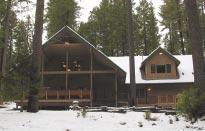
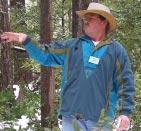
Berkeley researchers conducted some of the first work on prescribed burning as a management tool.
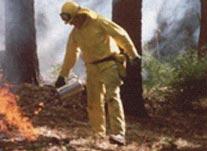
eligible to retire within the next five years. The College is well-positioned to provide the next generation of natural resource leaders.
As the population of California grows and the separation between urban and rural areas decreases, the forestryprogram at Berkeleyis more important than ever. The Collegeís forestryand fire experts routinelytestifyat Congressional hearings on issues such as wildfire management and protection of important natural areas such as the Lake Tahoe Basin. Max Moritz just joined the program as the nationís first Cooperative Extension specialist in fire management (see the Facultysection of this issue for more on Moritz).
And newtechnologies are allowing scientists to look at forest issues from myriad angles.
Says Standiford: ìTodaywe can look at the forest from molecular to global levelsóthrough a microscope, or from space. This allows us to understand forests in ways that were never before possible.î
The Facultyof Forestrycomprises more than 50 scientists and Extension academics throughout the College, in other areas of the Berkeleycampus, and in the UC Division of Agriculture and Natural Resources.


Arthur Sampson was an established plant ecologist when he joined the College of Agriculture in 1922. As a professor in the Division of Forestry, he launched the field of rangeland science with three important books between 1923 and 1928: Range and Pasture Management; Native American Forage Plants; and Livestock Husbandryon Range and Pasture.

Sampson was especiallyinterested in the ecologyof western ranges and began research that addressed issues still of importance today, such as managing undesirable plant species and the role of fire on rangeland ecology. He was one of the first researchers to studygrazing and watershed problems in the West, and the first to teach a continuing course in range management.
With the support of ForestryChair Walter Mulford, Sampson advocated an interdisciplinaryeducation for range scientists, supplementing range training with the physical, biological, and economic sciences. Ever since Sampsonís time, the rangeland science program at Berkeleyhas set itself apart as ecologicallybased and interdisciplinary.
Rangeland science continued to gain in stature as the California Forest and Range Experiment Station was located on the Berkeleycampus in 1925. In 1933, a Range Committee was established, at first to investigate the long-term effects of brush burning. Their results, which found no deleterious effects from systematic brush removal, eventuallyconvinced the legislature to remove some prohibitions against brushland burning.
Professor Emeritus Harold Heady, another keyfigure in the historyof rangeland science, joined the College facultyin 1951. Headywas the first to explain the dynamics of annual grasslands, with application to Mediterranean grasslands worldwide. He was awarded the Societyfor Range Managementís top honor in 1980 for sustained outstanding accomplishment in range management or science and received the Berkeley Citation in 1991.
Subsequent generations of students continued to make key discoveries about grasslands. Professor Jim Bartolome was the first to disprove a long-held theorythat purple needle grass dominated native perennial grasslands. He also discovered that annual grasslands can be managed productivelyfor biodiversityusing residual drymatter, a technique nowused routinely.
Others in the College challenged and refined models of ecosystem change in Mediterranean woodlands, analyzed grazing impacts on water quality, and documented landowner goals in the management of private rangelands.
Professor Barbara Allen-Diaz, originallya student in Bartolomeís laboratoryand nowExecutive Associate Dean of the College, illustrated that livestock could be used as a vegetation management tool in forests, as a chemical alternative. Livestock are nowroutinelyused to remove unwanted or invasive vegetation.
In 1986, the program was augmented bya newUC systemwide range program, the Integrated Hardwood Range Management Program. The IHRMP joins researchers across UC campuses to ensure sustainabilityof the stateís 10 million acres of hardwood rangelands.
Although CNRís range program has always maintained an ecological focus, computers led to changes in the wayresearch was conducted. ìThe cutting edge of range ecologyhas become more quantitative, with better theoretical models and an abilityto handle complex data sets,îsaid Bartolome. ìThere has also been a shift in the specific problems we work on. While previouslywe focused on livestock grazing, todaywe address more social issues.î
Associate Professor Lynn Huntsinger took an earlylead on social issues with research into rangeland landowner practices, goals, and values in California. This work helped launch the dramatic nationwide shift over the last 10 years in attention to private-lands conservation and landscape-level conservation programs, as well as the inclusion of human-values research and programs into rangeland management.
Allen-Diaz predicts that rangeland science of the future will still revolve around indicators for sustainability, involving the social and environmental effects of grazing animals. ìLivestock animals graze on more than half of the Earthís lands. Distribution and composition of grasslands and shrublands are keyto a wide varietyof issues, ranging from carbon storage and global climate conditions, to local economics and social structure of pastoral and nomadic societies.î
The programís interdisciplinarytradition will also continue. Said Bartolome, ìThe current organization of environmental science allows for a high level of collaboration byBerkeleyrange facultywith other environmental scientists. We have an 80-year historyof questioning traditional ideas in management and ecology.î

The 1920s provided a prime stage for the emergence of a world-class academic focus on agricultural economics at the College of Agriculture. The post-war economyled farmers nationwide to recognize the need to understand the economic side of agriculture. The 1925 Purnell Act allocated federal funds for the studyof agricultural economics and rural sociologyat the land-grant universities. And the Berkeleycampus gained a significant benefactor in Amadeo Peter Giannini, founder of the Bank of America.
Economist HenryErdman joined the Division of Rural Institutions in 1922. He studied the operation of various kinds of cooperative organizations in the state. Within a couple of years, he produced the first in what was to become a long historyof seminal contributions for agricultural economics in the College: a model constitution for organizing a cooperative. Companies like Sunkist and Sun Diamond originallyformed using this model.

By1926, the unit had been renamed twice, finallybecoming the Division of Agricultural Economics. HarryWellman joined the College as the first economics specialist in the Cooperative Extension Service. He and another College economist, E.C. Voorhies, produced the first series of crop and price outlook studies of crops and the poultryindustryover the next three years.
During this same period, Amadeo Giannini, the son of immigrant vegetable growers in the Santa Clara Valley, had established a verysuccessful, farmer-friendlybank. The Bank of Italy, later known as the Bank of America, was the first to pioneer branch banking and to expand into rural California. To honor Giannini on his 60th birthday, the bankís directors offered him a bonus of $1.5 million. In 1928 he donated the entire sum to the University. One-third of the moneywas earmarked for building Giannini Hall, and the rest to establish the Giannini Foundation of Agricultural Economics to support research bearing on the economic status of California agriculturalists. Giannini Hall was completed in 1930.
Today, the foundation continues to serve researchers at the three landgrant campuses, and its libraryboasts the worldís finest collection of publications and data related to agricultural economics.
The Collegeís economists have long contributed to national and international economic planning, and manyof the current facultycontinue to provide research support and analysis of state and federal legislation. Earlyon, facultyparticipated in the NewDeal and several took leaves of absence from campus to serve in temporaryfederal positions. In the 1960s, Professor Emeritus Irma Adelman was a senior advisor to the government of South Korea and designed that countryís second five-year
plan, which launched it on a strategyof export-led growth. The concepts for designing reforms of agricultural and food policies developed at the UruguayRound of the General Agreement on Tariffs and Trade (GATT) originated here.
The arrival of computers at the Universityin the 1960s transformed the field of agricultural economics from a descriptive to a quantitative science. Working with a refrigerator-sized, vacuum tube, magnetic drum computer, teaching assistant James Boles helped researchers link economic modes with machine computations. Boles later worked as both professor and chair of the department.


Other keyconcepts in agricultural and resource economics that originated with the Collegeís agricultural economists or that were developed based on work done here include:
■ Econometrics, or using statistical and mathematical methods to define numerical relationships between keyeconomic forces
■ Contingent valuation, a measurement vehicle for determining the value to societyof natural resources
■ Option value, an analytical concept that incorporates relevant uncertainties in the measurement of the gains and losses from environmental and resource projects, used to analyze sustainable natural resources, especiallybiodiversity
■ Economies of Scope, an economic theorystating that the average total cost of production decreases as a result of increasing the number of different goods produced.
In 1978, the growing importance of natural and environmental resources both in policydebates and in academic economic research led the department to change its name to Agriculture and Resource Economics (ARE).
Facultyin the department also direct and participate in the Collegeís Center for Sustainable Resource Development. The center facilitates the global interaction of natural resource professionals and researchers who work on common problems.
G ordon Rausser, former Dean of the College and two-time former chair of the department, sees agricultural economists as playing a key role in achieving natural resource sustainability. ìHowdo we design effective institutions and governance that balance economic growth and environmental quality?î
As the nationís top-rated program in agricultural economics, facultyand alumni from ARE are sure to help answer this question.
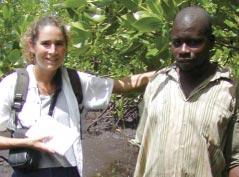
As societyís approach to resource and environmental issues has changed and understanding of the natural world has grown more complex, UC Berkeleyhas innovated and led the development of social sciences in the natural resources field.
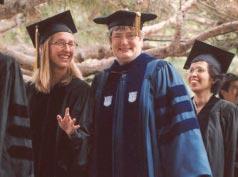
The College of Agricultureís first real advocate of social sciences was a civil engineer and irrigation expert. In an assessment prepared in 1911, Dean Thomas Hunt noted that the College needed to develop strong courses in rural economics and sociology. In 1913, he hired Elwood Mead to head the newDivision of Rural Institutions.
Mead was internationallyknown as a manager of irrigation projects, but he had a strong social vision. His experiences using irrigation plans to help with colonization efforts in Australia led him to believe that state-sponsored land settlement colonies could increase the economic and social value of small farms in California, and he convinced influential state leaders of this principle. So, while he developed academic coursework, his most notable contribution was the unprecedented integration of the Universityof Californiaís land development projects. Just as the land settlement program reached fruition, the United States joined World War I. A short agricultural boom was followed bya steep crash after the war ended.
Mead effectivelyleft the College in 1923 and Dean Hunt stepped down that same year. The Division of Rural Institutions was renamed the Division of Agricultural Economics in 1924 (see Agricultural Economics).
For the next decade, the College largelyavoided non-economic work on labor and social issues of agriculture, with one exception. Dean Claude Hutchinson served on a governorís select committee to investigate strike-breaking activityamong farm labor in the Imperial Valley. The committee concluded that worker agitation had been fostered byCommunists and Hutchinsonís zeal in this regard brought criticism and led the Universityand the Experiment Station to keep a lowprofile on labor matters for manyyears.
That changed in 1937 when Carl Alsberg, director of the Giannini Foundation, hired Dorothy Swane Thomas to join the facultyas a professor of rural sociology. In 1942, Thomas researched wartime relocation of Californiaís Japanese population to internment camps.

After WW II, social science at the College was largelyrestricted to economics. Within the School of Forestry, a newsubfield, forestryeconomics was launched (see Forestry). As the forestryprogram broadened, Berkeleywas the first to include a full-fledged social science program as a central element of its forestryprogram, including researchers in rural sociology, forest policy, and environmental history.
Social science was formalized as its own divisionóResource Institutions, Policy, and Management (RIPM)ówhen the Department of Environmental Science, Policy, and Management was created in 1992. In 2002, the name was changed to Societyand Environment in order to better reflect the nature of the research in the division. The division continues to grow, with a programmatic emphasis on equitable access to resources and environmental justice. Facultyare also stronglyinvolved in the globalization of resource issues and the division has just hired the first bioethicist on the Berkeleycampus.
Societyand Environment is in the Department of Environmental Science, Policy, and Management.


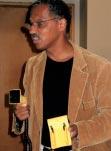
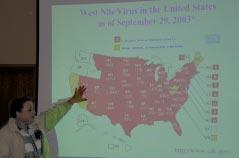

One of Eugene Hilgardís first scientific studies upon his arrival at Berkeleywas to examine grapevines suffering from infestation bya root louse, phylloxera. Although he was trained in chemistryand geology, Hilgardís application of the scientific method to help growers combat phylloxera established entomologyand pest management as core areas of research since the Collegeís inception.
Charles Woodworth joined the facultyin 1891 as the first entomologist with teaching responsibilities in California. He gave the first elementaryentomologycourse in 1882. For 29 years Woodworth headed what eventuallybecame the Division of Entomology. In 1920, parasitologist William Herms succeeded Woodworth and the division was renamed Entomologyand Parasitology.
Edward Oliver Essig, perhaps the worldís foremost entomologist at the time, joined the College in 1914. He offered the first course in insect pathologygiven in anyuniversity, and also developed a course in nematology. As part of the Agricultural Experiment Station, Essig, along with Earle G orton Linsley, also developed the California Insect Survey. The surveygrewout of the realization among entomologists that the most basic aspects of insect biologywere poorlyunderstood and expertise was not sufficient to address practical problems.
The surveyset out, and continues today, to develop and maintain research collections of all significant groups of terrestrial arthropods in California. Formalized as part of the Agricultural Experiment Station in 1939, the surveybegan with about 15,000 specimens and todaynumbers more than 5 million. The collections are housed on the Berkeleycampus in the Essig Museum of Entomology, which also holds collections from a long historyof noted Berkeleyentomologists.
ìThe outstanding work done on insect systematics formed the basis for work that continues today,îsaid David Wood, professor emeritus and former chair of insect biology, and professor of the graduate school.
In 1932, the College added chemist Roderick Craig to the faculty. He developed a pioneering program in insect physiologyand was among the first investigators to use radioisotopes in biological research.
At the same time the Berkeleyentomologyprogram was gaining notoriety, the Division of Beneficial Insect Investigations was established at the Citrus Experiment Station in Riverside. In 1923, a separate unit for biological control research was set up within the division. In 1944, the unit became the Division of Biological Control and moved to a small piece of propertynear the Berkeleycampus known as the Gill Tract.
Carl Huffaker, a leading population ecologist, was one of the first people to run the Gill Tract facility. In 1946, as one of his first tasks, he joined with USDAís James Hollowayto attempt to control invasive Klamath weed using classical biological control. The technique, which involves discovering and importing natural enemies from the countryof origin of a pest, had been spectacularlysuccessful in the late 1800s when the USDA imported vedalia beetles to control cotton cushionyscale on California citrus.
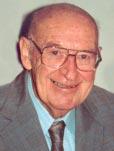

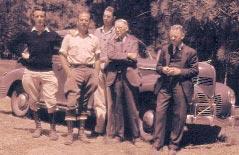
When theystarted the research, Klamath weed threatened grazing on 2.25 million acres of western land. Their efforts, which involved collection of Australian beetles that were natural enemies, resulted in total and permanent control of the weed. This was just the beginning of Huffakerís important contributions to the field of biological control.
Huffaker conducted experiments to elucidate the fundamental nature of predator-preyinteractions. He served as world coordinator for the biological control of spider mites. At the request of the National Science Foundation, he conducted a feasibilitystudyfor a long-term, nationwide, integrated pest control research program. The program, eventuallyfunded bythe National Science Foundation and the Environmental Protection Agency, involved 19 land-grant universities and segments of the USDA. The program, later known as the ìHuffaker Project,îserved as the prototype for integrated pest management programs (IPM) worldwide.
RaySmith, a Berkeleyalumnus who ultimatelyserved as co-leader of the Huffaker Project, joined the Division of Entomologyand Parasitologyas an assistant professor in 1946. He developed the technique called ìsupervised control,îthe routine monitoring of pest populations and their natural enemies in the field and prescribing what, if any, control is needed.
In 1959, Vernon Stern of UC Riverside and Berkeleyís Smith, Robert van den Bosch, and Kenneth Hagan published the seminal paper ìThe Integrated Control Concept,îin the journal Hilgardia, introducing integrated pest management as it is known today. Smith, who was particularlyactive in demonstrating and publicizing IPM techniques, received the 1997 World Food Prize for his efforts, along with PerryAdkisson of Texas A&M University.
In 1952, the division expanded into a department. Smith became chair in 1959, and led a restructuring that resulted in the Department of Entomological Sciences. The newdepartment had an academic instructional unitóthe Department of Entomologyand Parasitologyóand four autonomous research divisions: Biological Control, Entomologyand Acarology, Invertebrate Pathology, and Parasitologyand Medical Entomology. This broad-based program gained stature as the best entomologyprogram in the country.

Robert van den Bosch, who had been a student of Smithís before joining the department facultyin 1962, spent much of his career devoted to the advancement of biologicallybased pest control methods. Just before his death in 1978, he completed The Pesticide Conspiracy, which describes the influence of big business on the development and use of pesticides.
Pest management is still a crucial focus of the Collegeís entomologists. Donald Dahlsten, who passed awayin 2003, is credited with saving the stateís eucalyptus foliage industryin 1991-93 bydiscovering natural enemies to control psyllid pests, which attack certain varieties of eucalyptus trees. Today, entomologists in the Division of Insect Biologywork on the cutting edge of emerging pest problems, including control of codling moths in western orchards and Pierceís disease in grapevines.
ìEntomologyhas a lot to offer to the studyof emerging diseases,îsaid College entomologist Nick Mills. And with the development of molecular tools beginning in the 1970s, Professor Mills says the field has become more important than ever.
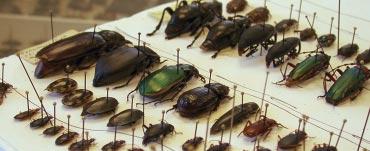
ìInsects have become veryvaluable model systems with which to look at more general and more basic aspects of biology, from genetics to physiologyto neurobiology. Insects are ideal because theyare small, relativelyeasyto handle in captivity, and have a short generation time, facilitating studies of natural selection.î
Biodiversityand conservation issues will also continue to be important topics for the group.
ìInsects represent two-thirds of all known organisms, and we mayhave onlydescribed ten percent of all the insect species on Earth. If you want to think about conservation of wild environments, and conserving the functionalityof an ecosystem, thatís likelygoing to involve insects,îsaid Mills.
The Division of Insect Biologyis in the Department of Environmental Science, Policy, and Management.
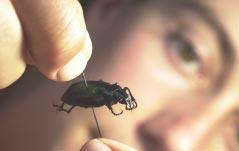

Although UC Berkeleydid not have an official Department of Nutritional Sciences until 1962, landmark human and animal nutrition research on campus dates back to the 1870s. Researchers that todaywould be in the nutrition department spanned a varietyof academic units in both the College of Agriculture and the College of Letters and Science.
At manyuniversities, the earliest nutrition research often came from animal agriculture, while academic instruction was assigned to home economics. This structure held true at Berkeley, when Myer Jaffa began to conduct nutritional studies. After completing a degree at Berkeley, Jaffa became assistant chemist of the Agricultural Experiment Station in 1879 and in 1918 was appointed as the first professor of nutrition in the nation.
Jaffa conducted the first food analyses and dietarystudies of Chinese immigrants and the vegetarian communityin the BayArea. Through his work on food chemistry, he was also largelyinstrumental in the passage of the California Food and Drug Laws, which were formulated on the same basis as the Federal Food and Drug Act of 1906.
From 1909 to 1916, there was increasing interest in training home economics teachers in California. In 1916, UniversityPresident Benjamin Ide Wheeler established a Department of Home Economics in the College of Agriculture to meet this need.
In 1915, Agnes FayMorgan joined the College of Agriculture as an assistant professor of nutrition. The following year, nutrition and dietetics courses were moved from the College of Agriculture to the College of Letters and Science. Home Economics was split into ìhousehold artîand ìhousehold science,îthe latter under the direction of Morgan.
In 1938, the Department of Household Science returned to the College of Agriculture and was renamed Home Economics. The household art offerings remained in L&S, forming the Department of Design.
Meanwhile, scientists in other L&S research units on campus were making keydiscoveries about nutrients. Anatomist Herbert Evans and physiologist Katherine Bishop discovered vitamin E in green leafyvegetables in 1922. Evans isolated vitamin E in 1936, as well as linolenic acid in 1934.


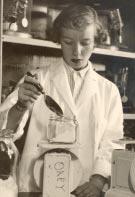
In the College of Agriculture, poultryscientists were making important scientific advances that benefitted both animal and human nutrition. Tom Jukes was interested in improving the health of livestock, and his postdoctoral work in the poultryhusbandryunit led to the discovery that vitamin B was actuallya complex of several compounds. In 1936, his collaboration with Samuel Lepkovskydemonstrated that a critical substance, later known as the vitamin pantothenic acid, prevented skin disease in chicks.
In 1938, Lepkovskywas the first to report the isolation of pure crystalline vitamin B6. During his service in WWII, he contributed greatlyto the development of combat rations. After returning to Berkeley, Lepkovskypioneered the newfield examining the role of the central nervous system in appetite, digestion, and satietyóa field still under investigation.
Robert Stokstad, under Herman Almquist in the poultryscience unit, conducted his postdoctoral research on a hemorrhagic chick disease caused bya nutritional deficiency, and the missing factor was later shown to be vitamin K. Stokstad then left the Universityfor private industry.
Graduate studyand research in nutrition began in 1930, organized under a graduate group in animal nutrition. In 1946, Agnes Morgan became chair of the group and renamed it ìNutrition.îBetween 1931 and 1962, nearly300 scientific papers, 133 masterís degrees, and 35 Ph.D.s came out of this group.
In addition to her teaching and administrative responsibilities, Morgan conducted groundbreaking research on vitamin deficiencies. She was the first to detect the role of a B vitamin in adrenal function and in the pigmentation of skin and hair. Morgan also coordinated the first nationwide studies of the nutritional status of U.S. citizens.
Two years after Morganís 1954 retirement, the unit was renamed the Department of Nutrition and Home Economics. In 1961, the Department of Food Science and Technologymerged with the nutrition program, adding strengths in food chemistryand biochemistrywith notable researchers like Maynard Alexander Joslyn, one of the founders of food technologyscience. In June 1962, the last general home economics degrees were awarded and the department name was changed again, to Nutritional Sciences.
In 1963, Robert Stokstadófamous bynowfor his work on folic acidó returned to Berkeleyto join the facultyof the Department of Nutritional Sciences. His research group contributed keyfindings on the metabolism of folic acid, vitamin B-12, and methionine. Theywere the first to isolate manyof the mammalian enzymes involved in folate metabolism. This research continued into the 1970s, when the group developed methods to allowthe identification of individual folate forms in biological samples. Stokstad and his colleague Tsenonobu Tamura also performed some of the first definitive studies on food folate bioavailabilityin humans, using volunteer subjects living in a suite on the top of Morgan Hall that became known as ìthe Penthouse.î
Doris Callowayalso used the Penthouse to take human balance studies of protein and minerals to a newlevel of precision. Volunteers were confined there for up to three months while being kept on a strictly measured diet, often composed of purelysynthetic ingredients. Researchers monitored aspects of nutrient metabolism down to the routine loss of skin cells. Her work, known as the Penthouse studies, became a model for careful dietaryresearch.
In addition to carrying out her research, Callowaytook on the position of campus provost óthe first woman to hold the jobóin 1981. In the

same period she also organized a complex intercampus investigation of the contrasting nutritional problems of young children in three developing countries.
When the College of Natural Resources was established in 1974, it included the Department of Nutritional Sciences. Researchers began to collaborate with economists and other researchers to explore nutritional problems related to worldwide food distribution, and specificallyto Native American communities in the West and newimmigrant groups from Asia.

In the latest CNR reorganization in 1992, the department added toxicologyto its name and embraced those toxicologists previously working elsewhere in the College. The related Center for Weight and Health was also created during this time to establish multidisciplinary research and outreach efforts to combat the growing epidemic of obesity in America.
Metabolic studies continue to be the cornerstone of research at the Department of Nutritional Sciences and Toxicology, but todaytheyuse the tools of modern molecular biology. One group, for example, is studying the genes responsible for the synthesis of the enzymes involved in the deposition of fat in our tissues and their hormonal control. Another is studying genetic factors connected with folate metabolism that relate to the risk of vascular disease and neural tube defects in embryonic growth.
There is also interest in developing newways of measuring metabolism in whole organisms, rather than just in a single tissue. ìThis is analogous to the work in other parts of the College studying a whole forest ecosystem rather than just one tree at a time,îsaid Professor Emeritus Kenneth Carpenter. ìFoods are not just sources of nutrients; theymay contain valuable anti-cancer agents such as the indoles in plants of the cabbage familyand some proteins in soythat are presentlybeing studied.î
One particular practical development of the departmentís work has been the modification of the treatment available for the two billion sufferers from iron-deficiencyanemia in the world. It has nowbeen confirmed that byspacing out the dosing with iron salts to weeklyintervals, the side effects that had forced manypatients to give up treatment can be virtuallyeliminated.
The challenge of the next centuryfor metabolic researchers will be to understand howthese complex metabolic networks are controlled and howto use the information being gathered about the human genome.


Eugene Hilgard assumed the dutyof teaching botanyfor the campus in 1876, taking over a course originallytaught byJoseph LeConte. In 1890, basic plant biologymoved out of the College of Agriculture into the Department of Botany, which was established in the College of Natural Science (nowthe College of Letters and Science).
Earlyplant biologyresearch in the College of Agriculture often had direct application to agriculture, such as development of improved crop varieties: smut-resistant wheat, better malting barley, higher-yielding Sudan grass for forage, leguminous cover crops for soil building, onions resistant to downymildew, hardier citrus and grape rootstocks, and better strawberries, melons, tomatoes, peaches, almonds, and maize.

In the early1900s, plant pathologyemerged as a strong field in the College, and Ralph Elio Smith founded the Department of Plant Pathologyin 1903. Over the ensuing 50 years, the department made significant contributions to the etiologyof bacterial diseases, the physiologyof rusts and mildews, and the nature of plant viruses and soil-inhabiting pathogenic fungi.

The first Division of Genetics at Berkeleyóand in the countryóalso originated in the College of Agriculture in 1913. Under the direction of Ernest Babcock, the divisionís research followed the expansion of genetics as a scienceóplant breeding research gave wayto experiments in taxonomy, leading to formal genetic studies of Drosophila and cytogenetic studies of tobacco and insects. For his own research, Babcock analyzed the genetic relationships and evolutionaryprocesses in a relative of the dandelion, Crepis. His detailed work on the genetic relationships of the 196 species of Crepis led to recognition of Babcock as one of the pioneers of biosystematics.
In 1908, Dennis Hoagland joined the facultyas instructor in animal nutrition, but left soon after to serve on a federal committee concerned with the impact of food preservatives on humans. Then he completed a degree in animal biochemistryin Wisconsin, and ultimatelyreturned to Berkeleyas an agricultural chemist for the remainder of his career.
In 1922, he became the head of the newlycreated Division of Plant Nutrition. Under his leadership, the division became an internationallyrenowned center of plant research. Hoagland did pioneering work on the mineral nutrition of plants, and with Daniel Arnon provided the basic formula for a nutrient solution (Hoaglandís Solution) that continues to be used worldwide for the cultivation of plants.
Arnon left the Universityto serve in World War II from 1943-46. While there, he applied his Berkeleyresearch successes to a project on Ascension Island to produce food plants in nutrient culture. The techniques developed there were later used as a model for the extensive nutrient culture farms that provided food for Douglas MacArthurís armyduring the occupation of Japan.
After he returned to Berkeley, Arnon turned his research attention to the process of photosynthesis. In 1954, he and his research team discovered photosynthetic phosphorylation, a finding that ranks in importance with the discoveryof respiration in animals. His team was also the first to obtain complete photosynthesis from chloroplasts outside the living cell (see storyin College Support).

In 1961, Arnon established the Department of Cell Physiologyto focus on photosynthesis and nitrogen fixation. Later this department became the Division of Molecular Plant Biologywithin the Department of Plant Pathology.

In the 1980s, the campus gave a critical look to the organization of biologyat Berkeley, which at the time cut across 20 departments in at least five colleges or professional schools. Internal and external reviews revealed that biologyís structure and organization were hindering recognition of the great intellectual power at Berkeleyin the field. As part of the ensuing reorganization, the Department of Plant Biologywas established in 1989. Facultyfrom several campus units, including botany, genetics, and molecular plant biologyjoined the newdepartment.
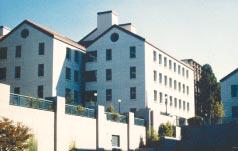
In the 1990s, deans Wilford Gardner and Gordon Rausser completed the reorganization of biologywithin the College to emphasize Berkeleyís strengths in interdisciplinaryenvironmental research amid discussions of removing Berkeleyfrom the land-grant system. The remaining separate biologydepartments, such as Plant Pathology, Soils, and Entomology, merged with social science researchers in 1992 to become the Department of Environmental Science, Policy, and Management.
The College also established a unique collaboration with the USDAís research agency, the Agricultural Research Service. Under the auspices of the Plant Gene Expression Center headquartered in Albany, California, researchers from both institutions collaborate based on their common interests in plant molecular biologyand genetics research. Most PGEC researchers are also adjunct facultyin the College.
Meanwhile, the field of microbiology, which in the 1940s resided in the Department of Bacteriologyand Immunologyin the College of Letters and Science, no longer had cohesive influence on campus. Medical microbiologists worked in the School of Public Health, but other microbiology researchers were scattered among several departments and colleges.
In the late 1990s, CNR Professor SydneyKustu approached then Chancellor Chang-Lin Tien with a proposal to revive the field of microbiologyas a unit on campus. He agreed, and in 1996 the Division of Microbial Biologywas established and combined with plant biologyto form the Department of Plant and Microbial Biology.
This group remains at the forefront of research on photosynthetic processes and products, plant molecular biology, plant genomics, plantmicrobe interaction, microbial biology, and plant physiological processes. Six facultymembers have been elected to the prestigious National Academyof Sciences.
Some of the facultyís accomplishments include:
■ First to isolate a bacterial gene that triggers a defensive response in plants
■ First to gain federal approval to run a field experiment using geneticallymodified bacteria
■ Discovered a primarymeans bywhich plants sense light to regulate enzymes of photosynthesis
■ Discovered genes that help plants resist disease
■ Established the field of fungal molecular ecology
■ Discovered the mechanism bywhich bacteria regulate the fixation and utilization of nitrogen
■ Elucidated the signaling pathwaybywhich plants perceive day length and use light in their development
■ Established the preeminent program for developmental genetics of an economicallyimportant plant, maize
■ Devised a system for the efficient production of hydrogen gas byalgae
■ Discovered that asexual fungi are recombining in nature
■ Discovered howthe crowgall bacterium transfers its DNA into the plants it infects, opening the door for widespread use of the bacterium to geneticallyengineer crop plants
■ Contributed to the sequencing of the first complete genome, of the mustard Arabidopsis.
And as with other areas of the College, Plant and Microbial Biologyis committed not onlyto research but to education and outreach. In 1991, PeggyLemaux joined the College as the first Cooperative Extension specialist in biotechnologyin the nation. Her role is to explain the newfrontiers of agricultural biotechnologyto the public. ì We need to help the public understand whywhat we do is so important,îsaid Lemaux.


ìBerkeleyis to soils as London was to the development of biologyor geology: if you want to studysoils, Berkeleyis the place to go,îsaid CNR soil scientist and professor Ron Amundson. Thatís because Eugene Hilgard was not onlythe father of what is todaythe College of Natural Resources, but he founded soil science as a distinct academic field of studyin the United States.
Hilgard, born in Germanybut reared on the American frontier (then Illinois), was largelyeducated byhis parents and familyin his earlylife, spoke four languages and read several more, and ultimatelygained widespread interest and education in chemistry, biology, and geology. Before he came to Berkeley, as the State Geologist of Mississippi, Hilgard published a landmark report on the geologyand soils of the state that clearlyset the stage for the studyof soils as a separate branch of scientific knowledge. For both his agricultural and geological research, he was elected to the National Academyof Sciences in 1873, though much of his career still layahead on the fledgling Berkeleycampus.
In 1875, Hilgard joined the College of Agriculture as a professor of agriculture and botany. He first put the newCollege on the national scientific stage in 1884 through his Cotton Census for the Southern States and California. Although focusing on cotton, the report served as the first synthesis of the soil geographyof California, including its first agricultural map. His outline of the geographical/soil provinces of the state is still used today.
During this time, Hilgard provided the first general framework explaining the roles of salts and sodium on crop production and water infiltration, research inspired byhis contact with agricultural constituents in the state. He determined that applying gypsum would remediate sodic soils and improve their structure and hydraulic characteristics, chemical principles that remain applied globallyto this day.
Under Hilgard, Universityinstruction was made available in soil chemistry, soil physics, and in the genesis and classification of soils. By1913, soil science courses crossed three divisions in the College: agricultural chemistry, soil chemistryand bacteriology, and soil technology.
ìCourses still taught on the Berkeleycampus originate from those first taught byHilgard in the late nineteenth century,îsaid Amundson.

In addition to his Cotton Census work, Hilgard moved in other directions, including the role of climate on soil formation, including temperature and moisture, and the correlation between arid and humid soils.
Other important soil scientists of the earlyprogram included Earl Storie and Hans Jenny. In 1934, Storie published the nowclassic agricultural land rating system based on soil properties. His system became known as the Storie Index, and is still used todayto rank soils for their productive potential. The Index also has continued present dayuse in land appraisal, tax assessment, and land-use planning.
In 1936, Jennyjoined the facultyand made signification contributions to the fields of colloid chemistry, ion exchange, and pedology. His signature work was the 1941 book
 Paul Bishop
Hans Jenny
Professor Ron Amundson sampling rock in the Atacama Desert of Chile.
Courtesy of Ron Amundson
Paul Bishop
Hans Jenny
Professor Ron Amundson sampling rock in the Atacama Desert of Chile.
Courtesy of Ron Amundson
Factors of Soil Formation, which virtuallyrevolutionized the conceptual and quantitative viewof the terrestrial world.

ìNo soil scientist in the historyof the Collegeóincluding Hilgardócommands greater international recognition than Hans Jenny,îsaid Amundson.
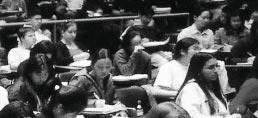
Throughout his life, Jennyís scientific contributions were driven bya true love of the soil, combined with a cool, analytical skepticism. In retirement, which spanned nearly25 years, he turned his passions to protecting rare soil ecosystems. Using his training in and love of art and nature, he became an important advocate of stewardship and conservation. His efforts led to the creation of Jug Handle State Reserve near Caspar, California.
With an expanded scope including soil physics and soil chemistry, the Division of Soil Technologywas elevated to the Department of Soils in 1951. In 1955, the soils group merged with the Department of Plant Nutrition to form a two-campus Department of Soils and Plant Nutrition at Berkeleyand Davis, led at the time byJenny. The two sections of the department became autonomous on their separate campuses with the 1964 appointment of separate chairs.
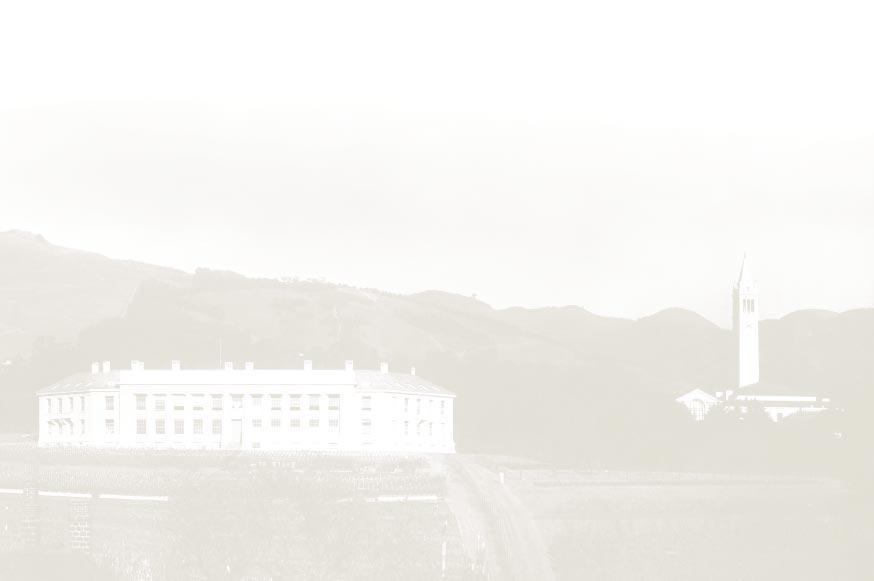
In the midst of these reorganizations, Hilgardís legacyof a stellar soil science program continued. In the 1950s, Professor RoyOverstreet and his graduate student, Kenneth Babcock, formed a team that would gain international recognition for their work bringing together the fields of soil colloid chemistryand chemical thermodynamics. Babcockís first Ph.D. student, Garrison Sposito, todaycontinues this long-standing tradition (see Facultyand Specialists/Awards).
In 1951, soil scientist and chemist Douglas McClaren joined the facultyand helped launch the field of photobiology. He conducted pioneering experiments to quantifythe role that microbes playin moving nitrogen through the soil, a field todaystronglyrepresented and advanced by Professor MaryFirestone.
In the 1980s (see Plant and Microbial Biology) the Department was renamed Plant and Soil Biology, though in 1988, it was again renamed the Department of Soil Science, reflecting its long historyand ongoing vision. As part of a major CNR academic reorganization in the 1990s, the department was dissolved and its facultymerged with the Department of Environmental Science, Policy, and Management.
ìAt Berkeleywe have an incrediblyrich heritage in basic soil science research,îsaid Amundson. He notes that the College is also well prepared for the application of soil science to a broad arrayof environmental issues.
ìIn our College, we have scientists looking at carbon at all levels, from molecular scales at mineral surfaces, to soil microorganism metabolism of organic compounds, to carbon storage and release, to the atmosphere at regional and global scales. With soils holding more carbon than the entire worldís vegetation and the atmosphere combined, the carbon cycle is clearlya field where soil scientists will continue to be veryimportant,îhe said.
The Collegeís soil scientists reside in the Division of Ecosystem Sciences in the Department of Environmental Science, Policy, and Management.

Assistant Professor Maximilian Auffhammer says his academic path was a process of discovering his interests: a bachelorís degree in environmental sciences from the Universityof Massachusetts, Amherst, led him to explore resource economics; he earned a masterís degree in econometrics from the same university. He went on to earn a Ph.D. in economics from UC San Diego. Nowhe joins the facultyat CNRís Department of Agricultural and Resource Economics.
Auffhammer studies the role of developing countries in climate change, with a special focus on China. The rapid economic and industrial development of that countryhas resulted in growing emissions of greenhouse gases from the burning of coal, and an increasing reliance on imported oil. He notes that per capita ownership of automobiles is about one percent of that in the United States, but sales increased bynearly70 percent last year. A major challenge is to update Chinaís power generation facilities from inefficient, Cold War-era coal-based electricitysources to state-of-the-art facilitiesóa transition that is well underwayin the coastal provinces.
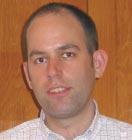
The countryís severe air pollution problems have tremendous implications for public health. Theyare focused on clearing up the air for the 2008 Summer Olympics, because of concerns that the air qualityis so poor it could affect athletesí performances.
Some of Auffhammerís recent work includes the first forecasts of Chinese carbon dioxide emissions based on provincelevel data, which provide some insight into what the potential causes of increased emissions will be over the coming decades. He believes that developing countries will playan important role in affecting climate change. The largest challenge, he says, is to figure out howcountries can raise the standard of living while limiting negative environmental consequences.
And the excitement, he says, is in watching such a dynamic economyevolve. ìThe speed of socioeconomic, political, and technological change we are observing in China has no precedent in recent history,îsaid Auffhammer. ìIt is an exciting time to studythese changes and Berkeley, with the large number of world-renowned facultyexperts on these issues, is the perfect place to do so.î
When set designers for the movie Spiderman wanted to know what a working spider laboratorylooked like, theycontacted Eileen Hebets and a colleague at the Universityof Arizonaó and received in return several boxes of posters and lab materials that ended up scattered around the movie set. The experimental spiders in the movie are housed in boxes exactlylike the ones Hebets herself designed for lab use.
Hebets is nowan assistant professor in the Division of Insect Biology. She joins the facultyfrom Cornell University. Hebets earned an undergraduate biologydegree from Albion College, a masterís degrees in biologyfrom the Universityof Cincinnati, and a masterís degree and Ph.D. in ecologyand evolutionarybiologyfrom the Universityof Arizona.
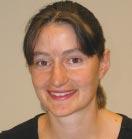
Hebets studies complex signal evolution in arachnids and focuses mostlyon the courtship displays of the wolf spider genus Schizocosa, as well as the potential for sexual selection to drive the rapid diversification of jumping spiders in the Southwest.
Some of Hebetsírecent research on wolf spiders led to the discoverythat young females, after being exposed to older males with different types of ornamentation, later preferred the same phenotypes when choosing a mate. This was one of the first examples of social experiences influencing adult mate choice in an arthropod. She plans to continue experiments that examine social exposure and memoryof spiders.
Hebets also seeks to learn more about the little-known arachnid order Amblypygi (whip spiders). Amblypygids are nocturnal arachnids found in the tropics and subtropics. They have eight legs, but onlywalk on six of them; the front two are long, modified legs covered with sensoryhairs. These legs are similar to the antennae of insects and contain giant inner neurons of an undetermined function.
Studying these virtuallyunknown arachnids means that Hebets has manyopportunities for groundbreaking work, such as her discoverythat a Florida Keys species of Amblypygid can breathe underwater.
ìFor some of these species, Iím probablythe first person to ever see their courtship and mating,îHebets said. ìAlmost everything I do is new, and itís reallyexciting.î
Max Moritz joins the College of Natural Resources as the nationís first Cooperative Extension specialist devoted to wildland fire.As part of the Department of Environmental Science, Policy, and Management, he will work closelywith the Collegeís Center for Forestry.
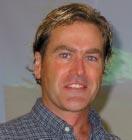
Moritz earned his Ph.D. in spatial ecologyfrom UC Santa Barbara. His doctoral thesis looked at the relationships between fire, weather, and chaparral vegetation in the Los Padres National Forest, and howfire suppression mayhave altered the ecosystems. He holds a bachelorís degree in management science from UC San Diego and a masterís degree in energyand environmental studies from Boston University.
He has broad expertise in fire modeling, fire effects, brushland fire ecosystems, and spatial patterns of fire disturbance.In addition to continuing his own fire management and ecology research, Moritz will serve as a link between facultyresearchers and countyCooperative Extension advisors. He will also provide direct links with professional resource managers, landowners, policymakers, and a diverse arrayof public and private organizations on issues related to fire.
ìWe develop and live on fire-prone landscapes, and our population is growingóso that development is going to increase,î Moritz said. ìGiven that fire is such an important mechanism, research and outreach related to fire is crucial.î
Before joining UC Cooperative Extension, Moritz was an assistant professor of geographyat California Polytechnic State Universityin San Luis Obispo.
The large wildfires of 2003 burned primarilyin shrubland forests, Moritzís specialty. Those fires generated national debate about what drives intense wildland fires, including fuel control strategies and their effectiveness.
ìItís an interesting time to be studying these topics, because thereís a lot of excitement about what fire suppression may have done in different ecosystem types,îhe said.
Due to ecosystem variation and unique drivers such as the Santa Ana winds, ìthereís no one-size-fits-all solution to this issue,îMoritz said. ìIt is a natural, recurring hazard in our landscape. We just have to learn to live with fire.î
Kathleen R. Ryan was convinced she wanted to be a doctor. So after earning her undergraduate degree in Historyand Science from Harvard University, she went on to the Medical Scientist Training Program at Johns Hopkins UniversitySchool of Medicine, where she eventuallyearned her Ph.D. in biochemistryand molecular biology.
Medical training, Ryan says, taught her that her real love wasnít medicineóit was science, and cell biologyin particular. She had been interested in cell biologysince an introductory course at Harvard, cotaught bymolecular and cellular biologist Howard Berg and Berkeleyalumnus and former botanyprofessor Daniel Branson (Ph.D. in plant physiology, 1961).
Ryan has nowjoined the Division of Plant and Microbial Biology, fresh from postdoctoral research at Stanford Universityís Department of Developmental Biology. Her current work focuses on Caulobacter crescentus, an aquatic bacterium that enters two distinct phases over the course of its life cycle. Caulobacter starts out as a mobile ìswarmerîcell with a polar flagellum, then differentiates into a stalked cell that then produces more swarmer cells.
Ryan says she was drawn to study Caulobacter because its cell cycle allows her to grapple with broader questions, such as howcells organize themselves and move their internal components. She is particularlyinterested in temporarycellular regulatoryevents, such as protein degradation and localization, and the establishment of polarization within the cell.

Although cell biologists frequentlyexamine the workings of plant and animal cells, bacterial cells have not received the same level of scrutinyóprobably, Ryan says, because technologyonlyrecentlyimproved enough to allowclose studyof bacteriaís tinier structures. ìI think people are surprised at how organized the insides of bacteria are,îRyan said. ìThere are plentyof old biologytextbooks that describe bacterial cells as bags of enzymes, and that is reallynot true.î
Her long-term goal is to explore howbacteria control cell cycle progression and howtheyachieve asymmetric cell division. Ryan also hopes to establish collaborations to develop new antibiotics that inhibit the natural cycles of bacterial cells.
óKellyHill
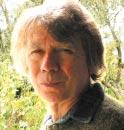
Inez Fung and Garrison Sposito have been selected to receive medals of accomplishment from the American Geophysical Union, the worldís largest societyof Earth scientists. AGU will present both medals at their annual meeting in December in San Francisco.
Fung, climate change pioneer
Inez Fung, one of the worldís pioneering researchers on global climate change and the Earthís carbon cycle, will receive the Revelle Medal ìfor excellence in research contributions to the atmospheric, oceanic, and terrestrial disciplines, and her strong scientific leadership.î

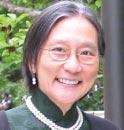
Fung is a professor in the College of Natural ResourcesíDepartment of Environmental Science, Policy, and Management and in the College of Letters and Scienceís Department of Earth and PlanetaryScience. She joined the UC Berkeleyfacultyin 1993 as the first Richard and Rhoda Goldman Distinguished Professor for the Physical Sciences and is the founding director of the BerkeleyAtmospheric Sciences Center.
In 1990, she deduced that the terrestrial biosphere has been absorbing a large fraction of the atmospheric carbon dioxide from fossil fuel combustion. Though controversial at the time, the terrestrial carbon sink has since been confirmed and has become a central negotiation theme in international protocols.
Fung is the acknowledged pioneer and principal architect of the field of Earth System Modeling, where the complex physical, biological, and chemical reactions on Earth are distilled into mathematical equationsóto be solved on the fastest computersóto predict the evolution of Earthís climate.Her current research is focused on whether global warming will be accelerated through destabilization of carbon storage in the biosphere.
In 2001, she was one of three women Berkeleyfacultymembers (in a class of 72) elected to the prestigious National Academyof Sciences.
Garrison Sposito will be awarded the Horton Medal ìfor his seminal and extensive contributions in establishing the physical and chemical foundations of hydrology.îThe Horton Medal was established in 1974 in honor of famed hydrologist Robert E. Hortonís contributions to the studyof the terrestrial water cycle.
Sposito is a professor in the Division of Ecosystem Sciences in the College of Natural Resources and in the College of Engineeringís Environmental Engineering program. He is considered among the top researchers in the fields of both environmental geochemistryand hydrology.
Sposito was the first Ph.D. student of CNR professor Kenneth Babcock.
Babcock, along with fellowCNR professor RoyOverstreet, gained international recognition for studies bringing together the fields of colloid chemistryand chemical thermodynamics as applied to soils, work which Sposito continues todayin his most recent book, The Surface Chemistryof Natural Particles. His research on hydrologic processes in soils seeks to establish the physical foundations of mathematical theories that describe water, solute, or energytransport.
Sposito is also recognized bycolleagues and students for his generous research collaboration and dedication to teaching. He offers a unique course, ìIntroduction to Environmental Studies,îalong with Robert Hass, Professor of English and former U.S. poet laureate (1995-1997), that brings together environmental science and the humanities.
The Encyclopedia of Insects received the 2003 award for Outstanding Single Volume Science Reference Book bythe Association of American Publishers. CNR professor of entomologyVincent Resh and Ring Carde, professor and chair of the EntomologyDepartment at UC Riverside, edited the encyclopedia. Fifteen Berkeleyfacultywere among the more than 250 authors that contributed to the book.
CNR professor RosemaryGillespie has been appointed to a second five-year term as director of the Essig Museum of Entomology, beginning in July2004. The museum contains more than 5 million specimens of terrestrial arthropods, collected over time since the 1880s.

In 1991, the museum received funds to upgrade and move the Essig Museum collection from Wellman Hall into the ValleyLife Sciences Building. The funds will be used to upgrade storage for the collection and to provide technical support for the relocation. Eleven faculty, in addition to Gillespie and JerryPowell, have been appointed as curators. These facultymembers, together with their students and postdocs, have expanded the taxonomic range of the museum to include moths and butterflies, beetles, wasps, bees and ants, true bugs, and spiders and ticks.
Patricia Zambryski, professor in the Department of Plant and Microbial Biology, has been awarded a Miller Research Professorship for the academic year 2004-2005. Zambryski will continue her research on two different projects aimed at understanding (1) howplant cells communicate with each other via intercellular channels called plasmodesmata, and (2) structure and function of the type IV secretion channel utilized byAgrobacterium to transport DNA through its membranes into susceptible plant host cells.
Appropriately named after one of the early founders of our College,the Hilgard Society recognizes our most generous donor s to the Berkeley Fund for Natural Resources.Because gifts to this fund are made without use restrictions,they benefit virtually all areas within the College,from student and faculty support to program development and research.One of the primary programs to benefit from the annual fund is the Undergraduate Research Opportunities Program.In 1875,Eugene Hilgard’s vision for the College was to bring the highest caliber of science to bear on practical problems and use this knowledge to train the next generation of leaders. Today,the Hilgard Society allows this vision to be carried into the future.Thank you.
Hilgard Society members are donors to the Berkeley Fund for Natural Resources whose cumulative giving is $250 or more annually.As we transition from a fiscal to a calendar year,please note that the following list is based on cumulative giving for the period of July 1,2002 through December 31,2003. Thanks again to all the members of the Hilgard Society for their commitment and support.
F.Eugene Forsburg,III,‘75 & Kass Green,‘74
Dr.Herbert M.Hull,‘46 & Mary M.Hull
James R.Lugg,‘56 & Marilyn G.Lugg
Monsanto
Dr.Robert O.Nesheim
Dr.Roderic B.Park & Catherine Bromage Park,‘66
Russell L.Rustici,‘48
Joel R.Singer,‘79
William L.Woods,III,‘73 & Kathleen C.Woods
Donald L.Haid,‘97 & Hallidie G.Haid
James P.Vokac,‘76 & Stacey T.Baba,‘77
Alexander & Baldwin Foundation
Professor Barbara Allen-Diaz,‘75 & David V.Diaz
Burton A. Anderson,‘49 & Alice V.Anderson
John V. Beahrs, ‘35 & Virginia Oakley Beahrs,‘34
Phillip S.Berry
Thorley D.Briggs & Gloria B.Briggs
John L.Casazza,‘77
Nancy Dawson Christensen,‘50 & Deal Christensen, Jr., ‘50
Robert E.Gilbert,Sr., ‘47 & Beverly S.Gilbert
Mary Beahrs Grah, ‘39
Dr.Suzanne Hendrich,‘82
Intel Foundation
Douglas S.Lipton,‘91& Cynthia E.Daniel
Dean W.Lloyd,‘49
Dean Paul W.Ludden & Linda Ludden
Iona Rockwell Main,‘49
Barbara Walsh Moser,‘80 & David E.Moser,‘81
Margaret Lockie Navarra,‘70 & Anthony J. Navarra
Barbara Schnoor Nielsen,‘49
David A.Nielsen,‘84 & Catherine R.Nielsen
Dr.Robert T.Porter,‘40 & Mary K.Porter
J.Roger Samuelsen,‘58 & Jeane Stewart Samuelsen
Dr.Scott S.Sibbett, ‘79 & Karen Hansen
Sibbett,‘79
System Experts Corporation
Henr y Vaux,Jr.,‘62 & Prindle Vaux
Professor William E.Waters
Weyerhaeuser Company Foundation
Anonymous
Richard H.Allan,‘82 & Kelly L.Allan
Diane J.Appel,‘85 & Daniel M.Cotton,‘90
Daina Dravnieks Apple,‘77 & Dr.Martin A. Apple,‘68
Michael B.Beeman,‘67 & Marianne Beeman
Dr.James L. Clay ton, ‘65 & Marilyn F.Clayton
Elizabeth Fordyce Cuff,‘80 & Christopher C.Cuff
Diane Yu, í96 (B.S., Nutrition) says she owes her present job as a research assistant with Lockheed Martin at NASA Ames Research Center to the College and to Cal. ìBerkeleyis a top tier school. I knowthat gave me an advantage here,îYu says.
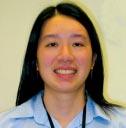
And the research and laboratorymanagement parts of her position stem directlyfrom her laboratoryexperience at CNR. Although she studied to be a dietician, an eight-month technician position with Professor Fernando Viteri led her to research.
ìDr. Viteri was looking at iron supplements in pregnant females. It was veryinteresting and he taught me a lot about researchóthat was the reason I decided to go into research instead of becoming a dietician.î
After graduating from CNR in 1996ómaking her among the most recent graduates belonging to the Hilgard SocietyóYu obtained an M.S. in Nutrition from Chico State University. While her current job doesnít relyon her nutrition education, it fits in with the research. She tests biological equipment for use in space.
As a donor, Yu takes advantage of the matching program at her company. ìLockheed matches dollar for dollar everydonation I give to an accredited university. I didnít realize that until the person who called to ask me for a donation to CNR pointed it out.î
Dr.Richard J.Dare,‘79
Joseph J.DiConza,‘68
John M.Fenley,‘39
Dr.Susan C. Flores, ‘77
Rosalyn R.Furukawa,‘75 & Dr.Jeffrey P.Solar,‘74
Kenneth Groefsema,‘4 8 & Priscilla Groefsema
Nelletje Groenveld,‘84
John H.Gross,‘47
Douglas M.Haefele,Ph.D.,‘85 & Eileen M.Robb,M.D.,‘76
Ann E.Harrison,‘82 & Vincente Madrigal,‘82
Kathleen Ohlson Hartzell,‘72 & Christopher J.Hartzell
Robert T. Hatamiya,‘56 & Lillian Y.Hatamiya
George R.Holden,‘47
Douglas E.Kain,‘76
Karen L. Khor,‘91
Professor Emeritus Watson M. Laetsch & Sita Laetsch
Dr.Yong L.Lee,M.D.,‘81& Deanna L.Lee
Lockheed Martin Corporation Foundation
Nancy Kresser Lusk,‘64
Professor Richard Malkin,‘67 & Carole J.Malkin
Byrne C.Manson
Dr.Ann McGowan-Tuskes,‘80
Dr.Elmer L.Menzie,‘61& Emily L.Menzie
Steven J. Merlo,‘73
Scott L.Miller,‘78 & Judey Wall Miller,‘75
John E.Pehrson,Jr.,‘51& Mary E.Pehrson
David Potter,‘36 & Elizabeth Lyman Potter
Rhonda S.Purwin,‘77
Phillip A.Rogers & Sally Toke Rogers
Rose M. Sarquis
Douglas M.Sinton,Ph.D.,‘73 & Wendy C. Sinton
Professor Emeritus Edward S.Sylvester,‘47 & Marian Uhl Sylvester
Shu Yang Tan,‘88
Roger Tsao & Theresa Y.Tsao
Raul N.Tuazon,‘84 & Mary Bartoloni Tuazon,‘84
Professor Emeritus James Vlamis,‘35 & Nancy MacBride Vlamis,‘38
Brett A. White,‘82
David L.White,‘79
Tim T.Wong,‘61& Effie L.Wong
Diane S.Yu,‘96
* Deceased
3M
Kathr yn Moriarty Baldwin & Gregory P.Baldwin
Dr.Martin M.Barnes,‘41
Richard H.Beahrs,‘68 & Carolyn Pardee Beahrs,‘67
William M.Beaty,‘38 & Georgia F.Beaty
Allison C.Blakley,‘78
The Boeing Company
Stephen P.Bradley,‘60 & Barbara R.Bradley
Steven S.Bremner,‘73 & Kathleen K.Bremner
Everett T.Brown,‘86
James A.Burris,‘41& Lois L.Burris,‘48
Charles Burton,‘74 & Georgia Burton
Dr.Diana M.Burton,‘86 & Dr.Harold A.Love,‘88
J.Kevin Carroll,‘93
Helen Chow,‘96
Li-Chiang Chu,‘64
Dr.James E.Constantz,‘73
Dr.Clytia Montllor Curley,‘85
Professor Emeritus Howell V.Daly,Jr.& Barbara B.Daly,‘61
Marian Koyama Endo,‘78 & Dean K.Endo
Professor Lewis J.Feldman,‘67
Josh C.Fisher,‘94 & Kara J.Fisher
Russell E.Forsburg,‘78 & Kathleen Mullen Forsburg,‘78
Jacob M.Frankel,‘40 & Barbara W.Frankel
Donald R.Franson,Jr.,‘74 & Anne Woolf Franson
Gina Frierman-Hunt,‘77 & Paul T.Hunt
Geraldine Wakiji Furuzawa,‘65 & Richard Furuzawa
Rudolf Glauser,‘67 & Alma E.Glauser
Lorna MacDonald Groundwater,‘91& Dr.
James R.Groundwater
Kathleen G. Gundr y, ‘74 & William B.Maly
Harriet L.Hamlin
Tracy E.Hart,Ph.D.,‘93
Thomas T.Hashimoto,‘81& Vickie Hashimoto
Shen L.Howng & Sue-Faye L.Howng
Leroy A.Jebian,‘64 & Winifred Camp Jebian,‘65
The Jon and Carole d’Alessio Family Fund of the Marin Community Foundation
Roger G.Jones,‘39 & Norma Jean Jones
A.Arlene Kasa,‘59
Kennedy Associates,Inc.
Joanna Renet zky Kingham,‘39 & Harry Kingham
David L. Knutson,‘53
Dr.Sabrina A.Lahiri-Field,M.D.,‘88 & Dr.James A.Field
Dr.Gary A.Lamberti,‘83
Matthew J.Lando,‘78 & Desta M.Lando
Donald T.Lauer,‘63 & Carol Millinich Lauer,‘63
Dr.Thomas T. Lawson,‘88 & Dina L.Rasor,‘78
Robert L. Leatherman,Jr.,‘49 & Inez N.Leatherman
Clifford A.Lee,O.D.,‘84
Douglas R.Leisz,‘50 & Marian A.Leisz
John T.Lerch,‘72 & Cathi L.Lerch
Ellen Maldonado,‘74 & Michael A.Chase,‘73
Thomas S.Mapes, ‘63 & Carol Jalonen Mapes,‘64
Robert A.McCord,‘71&
Tamara J.Jackson-McCord
Dr.Charles I. McNeill,‘75 & Joan Falkenberg McNeill,‘73
Jennifer Simone Money,M.D.,‘86 & Samuel Money,M.D.
Mary Jo Hilliard Morris & Jim Morris
James A.Nicholson
David C. Nuban,‘82
Ronald Okimoto, ‘79 & Barbara L.Okimoto
Judith A.Olney,‘79
Susan R.Orbuch,‘86 & James Gilbert
Brian R.Payne,Ph.D.,‘61&
Almuth Fahrenbach Payne,‘61
Dr.Klaus W.Radtke,‘81& Yoshiko Radtke
Naftali Sauerbrun,M.S.,‘73 & Raya Sauerbrun
SBC Foundation
Tom G.Schwan,‘83
Frederick M.Shanks,‘53 & Catherine Rhorabough Shanks,‘53
Dr.Harvey J.Stein,‘91& Irina G.Stein,‘85
Walter E. Stern,III,‘78 & Mary M.Stern
Dr.William C.Stewart,‘86
Michael T.Sullivan,‘73 & Mary Mulligan Sullivan,‘75
The United Way of the Bay Area
Mark L.Travis,‘88 & Annabelle E.Travis
Kai Umeda,‘78 & Diane J.Umeda
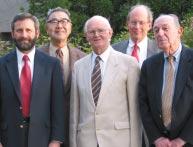
On March 1, plant biochemist
F. Robert Whatley returned to Berkeleyafter 40 years to honor the memoryof Professor Daniel Arnon and to celebrate the 50th anniversaryof their discoveries on plant photosynthesis.
To a full house in 101 Barker Hall, Whatleyrecounted what was known about chloroplasts and photosynthesis in 1953. ìWe knew that ATP was important in photosynthesis and also that chloroplasts produced starch.î
The common scientific viewat the time was that photosynthesis depended on both chloroplasts and mitochondria. It was generallybelieved that chloroplasts merelyproduced a reductant that allowed for generation of ATP in the mitochondria. ATP (adenosine triphosphate) is a molecule that carries cellular energyin all organisms.
ìWe had difficultyaccepting this view, because there were not enough mitochondria present to account for the amount of ATP that was needed,îhe said. ìWe deduced that chloroplasts themselves must be able to use light to make ATP.î
In 1954, after isolating whole chloroplasts from spinach leaves, Arnon, Whatley, and Mary Belle Allen discovered photosynthetic phosphorylation, the process bywhich chloroplasts use the energyfrom sunlight to synthesize ATP. Theyalso demonstrated for the first time that complete photosynthesis could occur in whole chloroplasts outside the cell, establishing chloroplasts as the onlycellular organelle necessaryfor photosynthesis.
ìWe had positive results on our first try, which was verysatisfactory,î Whatleynoted.
Scientific acceptance of their work, however, came onlyafter several years of discussion and further research.
Arnon and his team, including several graduate students and postdocs, went on to discover other important aspects of photosynthesis, including the role of chloride, plastoquinone, and ferredoxin.
In their initial discoveries, oxygen served as a catalyst for the chemical reactions, but the team later found howthe process could be accomplished anaerobically. Theyalso experimentallyseparated the light and dark phases of photosynthesis. Ferredoxin was one of the first in a newclass of iron-sulfur electron carriers present in a wide varietyof organisms. This protein is required for the accumulation of the reductant (NADP) and ATP needed for complete photosynthesis.
Although his group contained at most 20 individuals at a time, numerous students and postdocs trained in his lab rose to positions of national and international importance in research and academia, and his legacyof research on photosynthesis continues to this day.
Dr. Whatleyís talk was given as part of the Daniel I. Arnon Memorial Lecture series, established in 2000 bythe Department of Plant and Microbial Biology. The Department is fortunate to hold several annual lectures like the Arnon program, including the Tsujimoto and Buchanan lectures, which are sponsored bythe K/T Foundation of San Francisco.
* Deceased
For two decades, UC Berkeley has offered a unique venue for students and researchers to study science and culture in the tropics: the Richard B. Gump South Pacific Research Station on the island of Moorea.

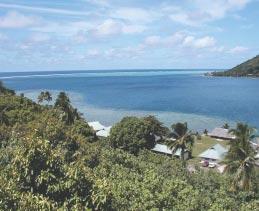
Moorea, a 1.2-million-year-old volcanic island, is one of the SocietyIslands of French Polynesia. Located 14 kilometers northwest of Tahiti, Moorea has freshwater streams, forestcloaked mountains, a well-developed coral reef and lagoon system, and a rich cultural history. The Gump Station is UCís only research facilityin the tropics as well as its onlyinternational field station.
In 1977, Mr. Richard Gump of Gumpís San Francisco began conversations with the Berkeleycampus administration about donating his spectacular propertyoverlooking the entrance to Cookís Bayon the north coast of Moorea. Mr. Gump was an extraordinaryindividualóa renaissance manówith a great love of Polynesia, its people, and natural ecosystems. After four years of planning and negotiation with the local government, the land was transferred to the Universityand Mr. Gump funded the first buildingóstill the stationís principal dormitoryon the waterfront.

The station was named in 1984 and its administration moved from the Chancellorís Office to its present home in the College of Natural Resources. The following year the station was officiallyinaugurated at a March 9 ceremonyin Moorea. It subsequentlyhas flourished under three facultydirectors: professors Werner Loher, Vincent Resh, and since 2001, George Roderick.
The young station was able to growthanks to the continuing support of Berkeleyalumnus Gordon Moore, his wife Betty, and their family, whose gifts have enabled the station to become one of the worldís premier tropical research facilities. The Gump Station has manyother generous friends, including Jerry McClaine, Dwight Barker (Chair, UC BerkeleyFoundation), and Don Raymond (CNR AdvisoryBoard member), who have worked tirelesslyon the stationís behalf.
Today, the 35-acre Gump Station can house up to 35 students and researchers. The most recent donation from the Moore FamilyFoundation is helping the station to meet an ever more rapidlygrowing demand for teaching and research facilities. These funds have also facilitated a major newoutreach initiative with the people of Moorea: the Atitia Center is a partnership between the University, the Mayor of Moorea, and a community-based organization, Association Te Pu Atitia. The aim of this effort is to document, preserve, and promote the biological and cultural heritage of Polynesia.
ìThe Gump Station is an ideal venue for students to learn about tropical environments and societies,îaccording to Roderick, an insect population biologist. ìAs an island, Moorea is a model system for addressing crucial global questions, such as howclimate change and globalization affect the dynamic relationship between humans and their natural environmentóa newfield known as biocomplexity.î
One of the outstanding features of Moorea is its coral reef lagoon; the warm protected waters provide an ideal laboratory for marine research and education. But the Gump Station is not solelya marine lab, Roderick noted. As a hot-spot archipelago, the SocietyIslands are well situated for studies in evolutionary biologyand biodiversityscience. Furthermore, Moorea has renowned archaeological sites and has been an active location for anthropologists.
ìMoorea is a windowinto a unique environment,îsaid Roderick. ìThe station gives students an experience impossible to replicate in a conventional classroom and the island provides researchers with an incredible natural laboratory.î
For more information about the Gump Station, visit http://moorea.berkeley.edu. An oral historyof Richard Gump is also available at Berkeleyís Bancroft Library.
Kathleen J. O’Hare,B.S.
John R.Evers,B.S.
David M.Huston,B.S.
Kong V.Kong,B.S.
Dr.Beverly Downing Penzien,B.S.
Jong W.Chung,M.S.
Leo H.Ellis,M.S.
Alfred Muller,M.S.
Walter R. Ross,M.S.
Dale E. Squires,M.S.
Sumter L.Travers,Jr.,M.S.
Stephen O.Andersen,Ph.D.
Mark R.Gustafson,Ph.D.
Darrell L.Hueth,Ph.D.
Wesley N.Musser,Ph.D.
Peter W. Wyeth,Ph.D.
Dr.Robert J.Ahrens,B.S.
Rolan P.Akers,B.S.
David A.Beveridge,B.S.
Douglas W.Canete,B.S.
Michael D. Cohen,B.S.
Winston P. Dea,B.S.
Elizabeth Yeaman Dozor, B.S.*
Michele Marchese Gibbs,B.S.
Martha Johnson Gillespie,B.S.
Joel H.Grossman,B.S.
Dr.Sally Burger Hayati,B.S.
Wen H.Hsieh,B.S.
Karen Roth Knopf,B.S.
Karen S.Kwok,B.S.
Damon Lee,B.S.
Gregory Li,B.S.
Leanne Morinaka Maru,B.S.
Darr yl L.McLeod,B.S.
Dr.Dennis D. Murphy,B.S.
Gerald I.Nishikawa,B.S.
Bruce E.Quan,B.S.
Christine N.Quan,B.S.
Linda Ingham Rummel,B.S.
Catherine Sipe Shaul,B.S.
Mark A.Simko,B.S.
John H.Slater,B.S.
Stanley Turner,Jr.,B.S.
Daniel E.Vaughn,B.S.
Kerwin K.White,B.S.
Arthur P.Wong,B.S.
Dr.Devon Zagory,B.S.
Gamalat A.Abdel-Latif,M.S.
Benjamin Graham,Jr.,M.S.
John T.Scholz,M.S.
Richard E.Yescott,M.S.
Eleni Zanni-Economou,M.S.
Gary L.Piper,Ph.D.
Conservation of Natural Resources
Dr.Mark R.Abbott,B.S.
Flemming Badenfort,B.S.
Kathleen F.Bain,B.S.
Dwight C.Baker,B.S.
Steven S.Balling,B.S.
Ronald D.Barngrover,B.S.
William L.Bart,B.S.
Diane M.Battilana,B.S.
Mary A.Benton,B.S.
John A.Berry,B.S.
William J.Birt,B.S.*
Richard E.Blake,B.S.
Richard H.Blum,B.S.
Jeffrey T.Boyer,B.S.
Jeffrey W.Boyes,B.S.
Antoni Bozynski,Jr.,B.S.
Carol Dehart Briggs,B.S.
John A.Brownson,B.S.
Lisa Bud-Frierman,B.S.
Josephine M. Bunn,B.S.
Charles Burton,B.S.
Charles D.Butler,II,B.S.
Steven A.Calish,B.S.
Eric P.Carr,B.S.
Michael H. Chin,B.S.
Willis K.Choy,B.S.
Dorothy A. Cole,B.S.
William E.Combs,B.S.
Paula Riordan Connelly,B.S.
Lauren H.Coodley,B.S.
Thomas S.Corse,Jr.,B.S.
Gary R.De la Rosa,B.S.
Nona Donahue,B.S.
Michael E.Dubrasich,B.S.
Samuel B.Earnshaw,B.S.
Maryjo Ef fron,B.S.
Jane A.Ellis,B.S.
Jacqueline L.Faike,B.S.
In honor of this special 30th anniversary, Breakthroughs is proud to present the first graduating class of the College of Natural Resources.Please use the enclosed Class Notes form to let us know how you’re doing!
Fassil Fessaha,B.S. Jessica Fielden,B.S. Robert M. Firth,B.S.
Vicki G.Fischer,B.S. Constance Barnes Fisher,B.S. Ann R.FitzSimmons,B.S. April E.Fletcher,B.S. Vernita P.Fort,B.S.
Michael E.Fry,B.S.
Gary L.Fulcher,B.S.
Gayle M.Galloway,B.S.
Marilie D.Gammon,B.S.
Bruce F.Goines,B.S.
Kirk C.Gothier,B.S.
Louise Spalding Grandadam,B.S.
Dr.Nancy M.Green,B.S.
John W. Greene,B.S.
Jason M.Greenlee,B.S.
David B.Griffin,B.S.
Kathleen G. Gundry,B.S.
Dr.Pamela M.Gurnick,B.S.
Dr.Ann E. Hajek,B.S.
Robert G.Hare,B.S.
David D.Hastings,B.S.
Carolyn B.Heath,B.S.
Sheila P.Higbif,B.S.
Shelley Kushnick Hubner,B.S.
Kenneth W.Huie,B.S.
Kerry Willmer Jackson,B.S.
Gwendolyn C.Jang,B.S.
Michael E.Jani,B.S.
Robert E.Jaramillo,B.S.
Tom A.Javits,B.S.
Jeffrey D.Johnson,B.S.
Terry A.Jones,B.S.
Richard A.Kawin,B.S.
Penelope E.Kellar,B.S.
Sharon Blum Korotkin,B.S.
Ruth Schenck Kreshka,B.S.
Barry J.Le Ducq,B.S.
Joseph R. Longacre,III,B.S.
Hilary Ewing Lorraine,B.S.
Steve J.Love,B.S.
Gary K.Loy,B.S.
Malcolm A.MacFarlane,B.S.
Elisabeth M.Magnus,B.S.
Dr.Claire C.Magowan,B.S.
Ellen Maldonado,B.S.
Nadine D. Mandel-Toren,B.S.
Christin Church McCollum,B.S.
Duncan M.McElfresh,B.S.
Michael V.McMillan,B.S.
Ann K.Meneguzzi,B.S.
Rei Miike,B.S.
David J.Miller,B.S.
Gregory E.Moore,B.S.
Wayne A.Munsey,B.S.*
Ruth E.Murayama,B.S.
Dr.Lawrence K.Nelson,B.S.
Ruth A.Newman,B.S.
Christopher L.O’Brien,B.S.*
Brian A.Pace,B.S.
Raymond D.Pacheco,B.S.
Chris Papageorge,B.S.
Dr.Anne Z.Parker,B.S.
David A.Pelzer,B.S.
Debra J.Ragen-Coffman,B.S.
Frances A.Rappoport,B.S.
Daniel L.Robbins,B.S.
Dale A.Roberts,B.S.
Russell W.Rollins,B.S.
Michael E.Ross,B.S.
William C.Ross,B.S.
Richard T.Sander,B.S.
Suzi L.Sargent,B.S.
Dr.James M.Satt,B.S.
James B.Schaber,B.S.
Fayla C.Schwartz,B.S.
Steven R. Scott,B.S.
Edward J.Seifert,B.S.
Tana Hill Sholly,B.S.
Philip E.Sloan-Tierney,B.S.
Ronald W.Smith,B.S.
Donna Y.Smith-Marion,B.S.
Thomas C.Snipes,B.S.
Judith Hopkins Snyder,B.S.
Ruth Spaulding Sorensen,B.S.
Arthur L.Stackhouse,B.S.
Edward B.Sternstein,B.S.
Laurence J. Tenison,B.S.
Vicki Lynn Testa,B.S.
Clifford B.Thomas,B.S.
Debra Eglit Tidd,B.S.
Nancy Keane Tosta,B.S.
A.Robert Tulk,B.S.
Janet Gertler Tulk,B.S.
James G. Villeponteaux,B.S.
Robert C. Walsh,B.S.
Kevin C.Westfall,B.S.
Lindsay Wheeler,B.S.
* Deceased
David C. Whitehill,B.S.
Leslie Williams,B.S.
Randall B.Williams,B.S.
Alice S.Wong,B.S.
John G.Wong,B.S.
Patricia S. Young, B.S.
Kam Fong H.Yu,B.S.
Frank A.Zander,B.S.*
Cynthia A.Bent,B.S.
Kathleen Oliver Carpenter,B.S.
Rebecca Ho Chen,B.S.
Patricia Yamamoto Christman,B.S.
Elizabeth Crocker O’Neill,B.S.
Laura J.Finkler,B.S.
Nancy C.Flynn,B.S.
Susan E.Foxton,B.S.
Constance Gabriel-Wilson,B.S.
Carol Ford Garberson,B.S.
Dorothy Nelson Giansiracusa,B.S.
Linda Meyer Hodge,B.S.
Pai-Hua Kuo Hsu,B.S.
Brenda Lee Irwin,B.S.
Helen A.Johnson,B.S.*
Margaret Humphrey Johnson,B.S.
Phyllis S.Lau,B.S.
Georganne C.Lawton,B.S.
Teresa Danieri McMahon,B.S.
Dr.Jan T.Okamura,B.S.
Craig A.Plumlee,B.S.
Vinette Pennisi Ramsay,B.S.
Madeleine K.Sui,B.S.
Sophia Fung Sum,B.S.
Lynn Muramoto Tso,B.S.
Carol Oaks Welch,B.S.
Carol Lee Yee,B.S.
Marilyn J.Dechant,B.S.
Kathr yn V.Freistadt,B.S.
Kim A.Hoelmer,B.S.
Richard A.Kimball,B.S.
John A.Morris,Jr.,B.S.
Nelda A.Soderblom,B.S.
Rosser W.Garrison,M.S.
Val R.Landwehr,M.S.
Wellington A.Otieno,M.S.
Patrick J. Shea,M.S.
Arthur J.Slater,M.S.
E.Alan Cameron,Ph.D.
Roger E.Gold,Ph.D.
Robert S.Lane,Ph.D.
Richard W.Merritt,Ph.D.
Zaheer Parvez,Ph.D.
Guy D.Rajendram,Ph.D.
Soemartono Sosromarsono,Ph.D.
Frederick M.Stephen,Ph.D.
George J.Tsiropoulos,Ph.D.
Victoria Y.Yokoyama,Ph.D.
Forestry
Henry G.Alden,B.S.
Christine Conrad Anderson,B.S.
Lloyd L. Anderson,Jr.,B.S.
Keith P. Arnold, B.S.
Dr.Keith B. Aubry,B.S.
Michael S.Barton,B.S.
William C.Beckett,B.S.
John R.Benedict,B.S.
Timothy Biddinger,B.S.
Michael T.Brown,B.S.
John H.Burns,Sr.,B.S.
Ann Paffenbarger Dow,B.S.
James M.Eckert,B.S.
Douglas C.Elliott,B.S.
Robert A.Gimbel,Jr.,B.S.
Frank H.Goddard,B.S.
Kass Green,B.S.
Michael E.Groth,B.S.
Duane H.Harp,B.S.
Richard R.Harris,B.S.
James P.Johnson,B.S.
Randy J.Kahn,B.S.
Lawrence A.Leavitt,B.S.
Charlene A.Metz,B.S.
David W.Norris,B.S.
Robert A.Obermeyer,B.S.
Jesse A. Rondestvedt,B.S.
Courtney M.Scandrett,B.S.
Steven P.Shiflett,B.S.
Jeffory A. Soto,B.S.
Craig T.Steggall,B.S.
Raymond G.Stine,B.S.
Raymond L.Tuttle,B.S.
Otto C.Vogelsang,Jr.,B.S.
Roy W.Webster,B.S.
George T. Williams,B.S.
Michael W.Wolber,B.S.
Ramiro A.Morales,M.For.
James C. Pfeifer,M.For.
John M.Elliott,M.S.
Bruce D.Krogman,M.S.
Bruce E.Krumland,M.S.
James R.Olson,M.S.
Dr.B.T.Parry,M.S.
John L.Philippou,M.S.
Mark R.Rutter,M.S.
Jesse N.Theuri,M.S.
Janet L.Thornton,M.S.
James A. Venturino,M.S.
Michael E.Walraven,M.S.
Brian K.Wood,M.S.
King-Tsuen Wu,M.S.
Kenneth S.Fowler,Ph.D.
Kani Isik,Ph.D.
Conrad J.Krass,Ph.D.
Genetics
Dr.Donald E.Campton,Jr.,B.S.
Dr.Darr yl L.Kropf,B.S.
James R.Popplewell,B.S.
Dr.Matthew M.Winkler,B.S.
Roger C.Birosel,M.S.
Carol Thompson Reed,M.S.
Catherine Cragen McCombs,Ph.D.
Juan F.Villarroel,Ph.D.
George W.Bain,B.S.
Thomas R.Batter,B.S.
Virginia H.Benson,B.S.
Patricia Benham Carlson,B.S.
Man-Wan Wong Chan,B.S.
Michael Chan,B.S.
Richard A.Cohen,B.S.
Thomas M.Cuff,B.S.
Lorri P.Dawson,B.S.
Ann M.Del Tredici,B.S.
Dr.Juan P.Delgado,B.S.
Emylyn L.Dohner,B.S.
Seid-Hossin Emami,B.S.
Gary R.Feldman,B.S.
Rose Y.Fong,B.S.
Helen Tsuboi Fukumoto,B.S.
Sheila Laughridge Hawthorne,B.S.
Cynthia Mock Hayano,B.S.
Janet L.Henick,B.S.
Thelma S. Ivu,B.S.
Dr.Sharon Korr,B.S.
Dexter S. Louie,B.S.
Clare Richards Lundgren,B.S.
Julia L.Mason,B.S.
Dr.Ronald Press,B.S.
Janice R.Spinner,B.S.
John P.Suzuki,B.S.
Meredith Grant Tallas,B.S.
Dr.Peter G. Tallas,B.S.
Dr.Laurel A. Waters,B.S.
Thelma S.Wu,B.S.
Linda Bair Smith,C.Phil
Janet Alberts Appel,M.S.
Arden Eisler Davidson,M.S.
Dr.Carl A.Goetsch,M.S.
Carolyn Moore Khourie,M.S.
Thierry A.Brun,Ph.D.
Catherine Tan Chan,Ph.D.
Janet B.McDonald,Ph.D.
Stanley G.Miguel,Ph.D.
Rajini P.Ranji,Ph.D.
Minnie R.Ruffin,Ph.D.
Barbara Olds Schneeman,Ph.D.
Tom R.Watkins,Ph.D.
Allison Y. Zezulka,Ph.D.
Parasitology
Kathleen H.Jeong,Ph.D.
Allan M.Phillips,B.S.*
Leonard L.Welch,M.S.
John J.Cho,Ph.D.
Dariush Denesh,Ph.D.
Thomas Duafala,Ph.D.
Ponciano M. Halos,Ph.D.
Joseph H.Hurlimann,Ph.D.
Jose R.Lastra,Ph.D.
John A.Muir,Ph.D.
Robert E.Paull, Ph.D.
Range Management
Peggy Robishaw Fox,M.S.
Soil and Plant Nutrition
Sheila Noe Hudson,B.S.
Michael L.Taylor,B.S.
Daniel R.Williams,B.S.
James T.Kam,Ph.D.
Soil Science
Eugene C.Duckart,B.S.
Kim C.Hayes,B.S.
Janice Darville Hess,B.S.
Jeffrey R.Higginbotham,B.S.
Mark P.Hite,B.S.
Bettie Buell Roof,B.S.
David E.Thomas,B.S.
John P. Reganold,M.S.
Giles M.Marion,Ph.D.
Adel M.Mohamed,Ph.D.
Wildland Resource Studies
Hernan J.Cortes,C.Phil.
Yoel Z.Alon,M.S.
Dr.Robert A. Ewing,M.S.
Henricus C.Jansen,Ph.D.
Wood Science and Technology
Vicente A.Molinos,M.S.
Andrew A.Pohlman,M.S.
Tseng S.Lee,Ph.D.
Leslie C.Palka,Ph.D.*
Jan Stofko,Ph.D.
A chance laboratoryarrangement more than 50 years ago led to scientific collaboration and a lifelong friendship between emeritus professors James Vlamis (above, left) and Robert Raabe.
Although theywere in different departments, Raabeís plant pathologylab adjoined Vlamisísoil science lab. Raabe, Vlamis recalled, ìis about the friendliest guyI know, and graduallyhe found out what I was working on, and I found out what he was working on.î
Their work fit together like seeds in a pod, Raabe focusing on plant diseases and Vlamis studying the soil chemistrythat affected plant health. Theycollaborated on manyprojects over the years, such as one studythat revealed the cause of a chrysanthemum disease known as red root. Other scientists suspected a pathogen, but Vlamisíand Raabeís work showed it was due to excess soil in the irrigation water.
Both men are still familiar faces at the Collegeís greenhouse at the Oxford Tract. ìWeíre both crazy,îRaabe jokes, ìbecause weíve been retired for years, and we both still come to work everyday.î
Theysaytheir reasons are simple, and the same. ìWe like what we do,îVlamis said. Raabeís lifelong love of plants stems from a $1.25 mail order package of 37 plants that, as a young boy, he ordered after hearing a radio advertisement. Most of the plants, Raabe recalled, were common onesóexcept for two gladiola seeds. One died. The other bloomed so magnificently that it inspired his lifelong love of plants. ìIt was taller than I was, and it was a beautiful red spikeóand I was hooked,îhe said.
Vlamis not onlytaught at the College, he was a student here, earning a B.S. in Forestryin 1935 and a Ph.D. in Plant Physiology in 1941. He discovered soil science while studying for his undergraduate degree in forestry. Dr. Alva Davis, the late plant nutrition and botanyprofessor, and Dr. Dennis Hoagland, late professor of agricultural chemistry, inspired him to pursue the field of plant nutrition.

While theywere teaching, Raabe and Vlamis together with D.E. Williams offered a class on urban garden ecosystems that showed students the basics of gardening. And after long and successful careers, Raabe, now79, and Vlamis, now89, still find their respective fields exciting.
ìThereís nothing better than finding out something newand interesting all the time,îRaabe said.
óKellyHill
While reading your fall 2003 edition and a recent UC alumni publication, I noticed a comment of a recent graduate that she had enrolled at Cal as a freshman in spite of the warnings of ìtoo big, too impersonal,î and found Cal to be quite the opposite.
I have reflected upon myown experiences at Cal in the College of Agriculture (nowCNR) and the Berkeleycampus. In those days (1938-1941) the Department of Plant Pathologywas headed byMax Gardner, who also taught an upper division class in diseases of vegetables and field crops. As months and years went by, he was not onlythe professor, he became an important advisor and a good and valued friend.
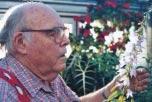
We visited the greenhouses of HenrySeverens and Julius Freitag, pioneers in the studyof virus transmission byleafhoppers. Our exposure in other departments included classes with E. O. Essig (Insects of Western North America) and Dr. Lee Bonar (Botany), world renowned mycologist.
In other undergraduate courses: Physics 2AB included in the curriculum three lectures on atomic energybyE. O. Lawrence. Our section leader was William Fretter, who later became Vice Chancellor. Wendell Stanleyvisited the campus in 1938, and before an overflowcrowd in Wheeler Auditorium, projected photomicrographs of tobacco mosaic particles, the first ever seen. Additionally, classes on economic theorybyJames Bennett and SidneyHoos (Giannini Foundation) and Agricultural Labor Economics byPaul Taylor (Economics) were included.
All in all, a veryimpressive group of professors for one who turned out to be a fertilizer salesman! Was Cal too big and impersonal? Not for me! I have treasured this exposure and education!
Sincerely,
Robert Brownscombe, í41, B.S., Plant Pathology
The feature story in this issue focuses on the contributions of our faculty over the years.Just as important are the thousands of alumni who have left the College to provide leadership and expertise throughout the world.Just a few of our distinguished alumni are listed here.
John Kenneth Galbraith, í32, M.A., í34, Ph.D., Economics, is internationallyknown for his development of Keynesian and post-Keynesian economics as well as for his writing and his active involvement in American politics. His manynotable positions include price czar during World War II; project director in the strategic bombing studies after World War II; editor at Fortune magazine; advisor to President Kennedy; U.S. Ambassador to India during the Kennedy Administration; a leader in the antiwar movement during the Vietnam War; and past president of the American Economics Association. He was awarded the 2000 Presidential Medal of Freedom.
Amihud Y. ìAbeî Goor, í23, B.S., í25, M.S., Forestry, was Israelís director of forestryresearch from 1948 to 1955, Arid Zone Advisor to the Forestryand Forest Products Division of the Food and Agricultural Organization in 1955, and the onlyCal Forester who served as a Regents Lecturer or Professor.
Ahmed A. Goueli, í62, M.S., Ph.D., í64, Agricultural Economics, served as Egyptís Minister of Trade and Supply, then as Secretary General to the Council of Arab Economic Unity. He is the winner of the 1998 Walter A. Haas International Award.
Kass Green, í74, B.S., Forestry, is former president of Space Imaging Solutions, one of the worldís largest satellite imageryand geospatial service firms. Prior to joining Space Imaging, she was president and co-founder of Emeryville-based Pacific Meridian Resources, another GIS consulting firm. She is a nationallyrecognized forestry and remote sensing consultant with more than 25 years of experience in natural resource policy, economics, and GIS analysis.
Zvi Griliches, (deceased) í53, B.S., Agricultural Science; í54, M.S., Agricultural Economics, was a pioneer in measuring the economic impact of technological change in agriculture.
Philip Habib, í52, Ph.D., Agricultural and Resource Economics, was a career diplomat and personal representative of U.S. presidents and U.S. ambassadors to the Middle East, Korea, and Vietnam. He negotiated an end to Israelís 1982 siege of Beirut. His manyhonors include the 1982 Presidential Medal of Freedom, CAA 1982 Alumnus of the Year, and the BerkeleyCitation for 1982.
Lawrence Klein, í42, B.S., Economics, won the 1980 Nobel Prize for the creation of econometric models and the application to the analysis of economic fluctuations and economic policies. He coordinated JimmyCarterís economic task force in a successful campaign for Presidencyof the United States.
Jennifer (Biddulph) Maxwell, í88, B.S., Nutrition & Food Science, is founder of Powerfood Inc. and creator of Powerbar with fellowCal alumnus Brian Maxwell (deceased).
Steve McCormick, í73, B.S., Agricultural Economics, is President and Chief Executive Officer of The Nature Conservancy. Under his leadership, the California program became the leading conservation organization in the state, protecting more than one million acres of important natural areas.
Julius Menn, í54, B.S., í58, M.S,. Ph.D., Entomology. served as associate director of the Plant Sciences Institute for the USDA/ARS in Maryland, and served as senior agricultural advisor to Turkmenistan on behalf of the U.S. Agency for International Development.
Emil Mrak, (deceased) í26, B.S., ë28, M.S., í37, Ph.D., Agricultural Science, is internationallyrecognized for his work on the preservation of foods and as a world authorityon the biologyof yeasts. He served as Chancellor of UC Davis from 1959 to 1969, and was the CAA Alumnus of the Year in 1969. Yair Mundlak, í57, Ph.D., Economics, made one of the first applications of decision theoretic framework to forecasting. He was the first full-time staff member in the department of Agricultural Economics at HebrewUniversity; under his ini-
tiative and leadership it soon became one of the leading departments of agricultural economics worldwide. He served as president of the Israel Foundation of Trustees from 1977 to 1988.
Norman Myers, í73, Ph.D., Interdisciplinary Studies, has been called ìthe Paul Revereîof the environmental movement. He is a leader in international efforts to save species at the brink of extinction byprotecting their habitats, and he originated the biodiversityhot-spot strategy. He has acted as a scientific consultant and policy adviser to the White House, the U.S. departments of State and Defense, NASA, the World Bank, seven United Nations agencies, and the European Commission. He is the winner of the 2004 Haas International Award.
Lloyd Swift, (deceased) í27, B.S., Agricultural Science; í30, M.S., Forestry, received the Chiefís Honor Award from the USDA Forest Service for a lifetime of dedication, commitment, and leadership in the wildlife and fisheries resources of the United States. As director of the Forest Serviceís Division of Wildlife Management, he had a major impact on wildlife management in the nationís forest lands. He served as executive officer of the U.S. appeal of the World Wildlife Fund and was a consulting biologist in Africa and the Middle East with the U.S. Agencyfor International Development and the United Nationís Food and Agriculture Organization.
Pinhas Zusman, í60, M.A., Statistics; í61, Ph.D., Agricultural Economics, has been recognized for the incorporation and measurement of social power in economic models. He was an advisor to the Agricultural Planning Center in Israelís Ministryof Agriculture, and served as director general of Israelís Ministryof Defense, vice president for Administration and Finance and director general atThe HebrewUniversityof Jerusalem. He is a past president of the Israeli Economic Association.
í39
Dr. John Morris Fenley, B.S., Forestryand Range; í48, M.S., Range and Forestry, has had his first book published. Living with Multiple Sclerosis ñ A Caregiverís Story discusses his 40-plus years of training and experience as a caregiver for his wife, Eileen Walker (also a Cal graduate).
í46
John M. Phillips, B.S., Forestry, says retirement is still great. He and his wife have been married 60 years, and, he says, ìour small Indian artifact and antique business keeps us out of mischief.îThey have five children, eleven grandchildren, and seven great-grandchildren. The Phillips live in Eugene, Oregon, and John adds that the hatch string is always out for classmates passing through.
í58
Dr. Julius J. Menn, Ph.D., Entomology/ Toxicology, is currentlyconsulting with the U.S. Department of Agricultureís Foreign Agriculture Service on food safety, and monitoring pesticides and mycotoxins in food and crops in Vietnam.
í67
George Jansen, B.S., Agricultural Economics, just had his first novel, The Scrapbook of Jesse James, published byHilliard and Harris. Over the years, he has collaborated on technical books on computer languages, operating systems, and most recently, the suppression of spam.
í70
David Rentz, Ph.D., Entomology, recentlyretired from 24 years of service to the Commonwealth Scientific and Industrial Organisation in Australia. He is nowliving in Kuranda, Queensland.
í74
Dr. Henricus C. Jansen, M.S., Wildland Resource Studies, and í69, B.S., Forestry, is a charter member of the Northeast California Resource Advisory Council and a professor in rangeland management at California State University, Chico. He has most recentlybeen working with the Bureau of Land Management conducting studies on the use of fire and other techniques to control invasive grasses on public lands.
Devon Zagory, B.S., Plant Pathology;í78, M.S. and í81, Ph.D., Plant Pathology, has a wife of 23 years, Ellen McEnroe, and an 18 year-old daughter, Jenny. He is the founder and owner of Davis Fresh Technologies, LLC, a fruit and vegetable consulting firm based in Davis, California, with offices in four countries and throughout the U.S. The firm offers services in produce qualityand safety, supplychain management, international shipping, strategic planning and business development, and application of technology.
Matt Winkler, B.S., Genetics and í79, Ph.D., Zoology, spent a year after his í74 graduation traveling in Africa and waiting tables. He completed postdoctoral positions at the Universityof Hawaii and UC Davis, then took a facultyposition at the Universityof Texas at Austin. After six years at the University, he started a biotech companycalled Ambion, which has grown to about 300 employees. He is married and has three sons.
í78
Mark Delfs, M.S., Forest Economics, retired from the U.S. Forest Service on Jan. 2. He is moving to Santa Fe, NewMexico.
Les A. James, B.S., Soil Resource Management, is dusting off his rÈsumÈ and taking introductory computer classes for PCs and Macintosh.
í82
Dan Kalb, B.S., Conservation of Natural Resources, is nowthe California Policy Coordinator for the Union of Concerned Scientists, working on air quality, renewable energy, climate change, and clean transportation issues.
Paul E. Jacobs, B.S., Conservation of Natural Resources, serves as chief of Mobile Sources
Enforcement for Cal/EPAís Air Resources Board in Sacramento, which strives to improve air quality for California residents.
í87
Laurie L. Williams, B.S., Conservation and Resource Studies, is nowworking in the U.S. territoryof American Samoa as Pacific Islands Technical Assistant, building local capacityfor geographic information systems (GIS) in coastal zone management.
í93
Binoj Joseph Matthew, B.S., Molecular Plant Biology, worked at Tularik, Inc. from 1993 to 1998 and was co-inventor on three biotechnologypatents. He obtained a lawdegree from Southwestern UniversityCollege of Lawand worked as a lawassociate in Los Angeles. He started his own business and nowowns and operates two state-licensed care facilities for the disabled. He is in the process of opening a statelicensed group facilityfor abused children.
í96
Sylvia Stone, B.S., Conservation and Resource Studies, completed a masterís of environmental science from Yale Universityís School of Forestry and Environmental Studies in 2000. She has worked for three years as a program manager in international conservation for the Wildlife Conservation Societyin NewYork and currently in San Francisco.
í00
Zac Unger, M.S., Range Management, became an Oakland firefighter. His book Working Fire: The Making of An Accidental Fireman, about his experiences as firefighter, has just been published by Penguin Books.
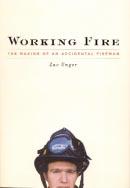
í01
Armaiti Khorshed May, B.S., Bioresource Sciences, is a third-year veterinarystudent at UC Davis.
Nadia Hamey, B.S., Forestry, is working as an assistant forester for Big Creek Lumber Company in Davenport, California.
For more exciting news and information about the College, go to http://nature.berkeley.edu.
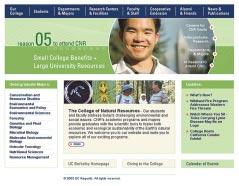

■ What’s new?
For current College news,visit our What’s New page. http://nature.berkeley.edu/whatsnew
■ Reflections on the Endangered Species Act
Read an interview with conservation biologist Steve Beissinger and resource economist Dave Sunding on the accomplishments and future of this important legislation.http://nature.berkeley.edu/esa
■ Sustainable agriculture exchange program
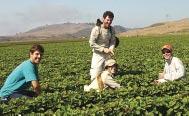
Learn about a student exchange program between CNR,the University of Nebraska, and two Brazilian universities. http://nature.berkeley.edu/brazil
■ L andmark books
View our ongoing compilation of seminal books and papers produced by College facult y. http://nature.berkeley.edu/books





■ City Watershed project
Find information about CNR’s outreach programs,including our newest K-12 project.http://nature.berkeley.edu/outreach
■ Student profiles
Read about CNR undergraduate students and their research projects. http://nature.berkeley.edu/student_profiles
■ Class notes
Share your news with us by using the online class notes form. http://nature.berkeley.edu/classnotes

Also on the Web: stayin touch with other College alumni byjoining Calís free online community, @cal. Go to https://cal.berkeley.edu/.

University of California, Berkeley
Office of College Relations

College of Natural Resources
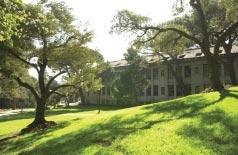
101 Giannini Hall #3100
Berkeley, CA 94720-3100 ADDRESS
Join faculty,staf f,students, alumni,and emeriti at CNR’s 30th anniversary party the night before Big Game.Visit our website later this spring for specific information,or watch for an invitation in the mail.We look forward to celebrating with you this fall!
MAY 23, 2004
College of Natural Resources Commencement
Chancellor’s Esplanade 10:00 a.m.
Featured Speaker: Paul Hawken

JUNE 28 -JULY 18, 2004
Beahrs Environmental Leadership Program
OCTOBER 15-17, 2004
Homecoming Weekend
Reunion Classes: ’44,’49,’54,’59,’64,’69,’74,’79,’84,’89,’94,’99
NOVEMBER 19, 2004
CNR 30th Anniversary Celebration